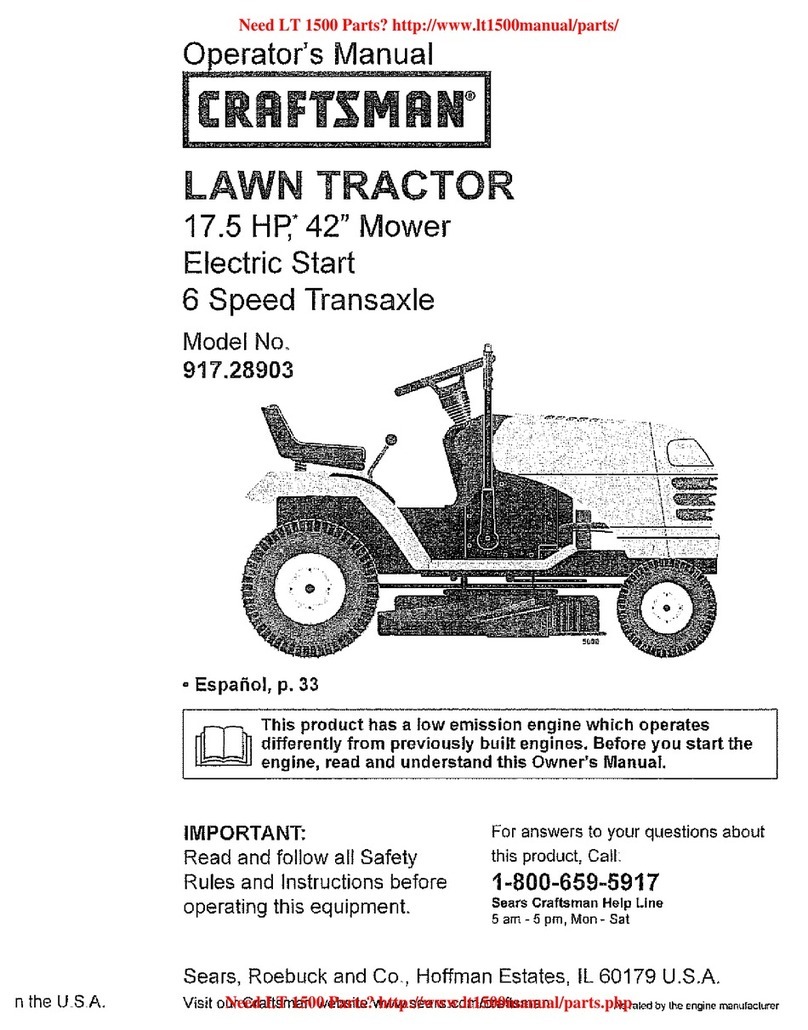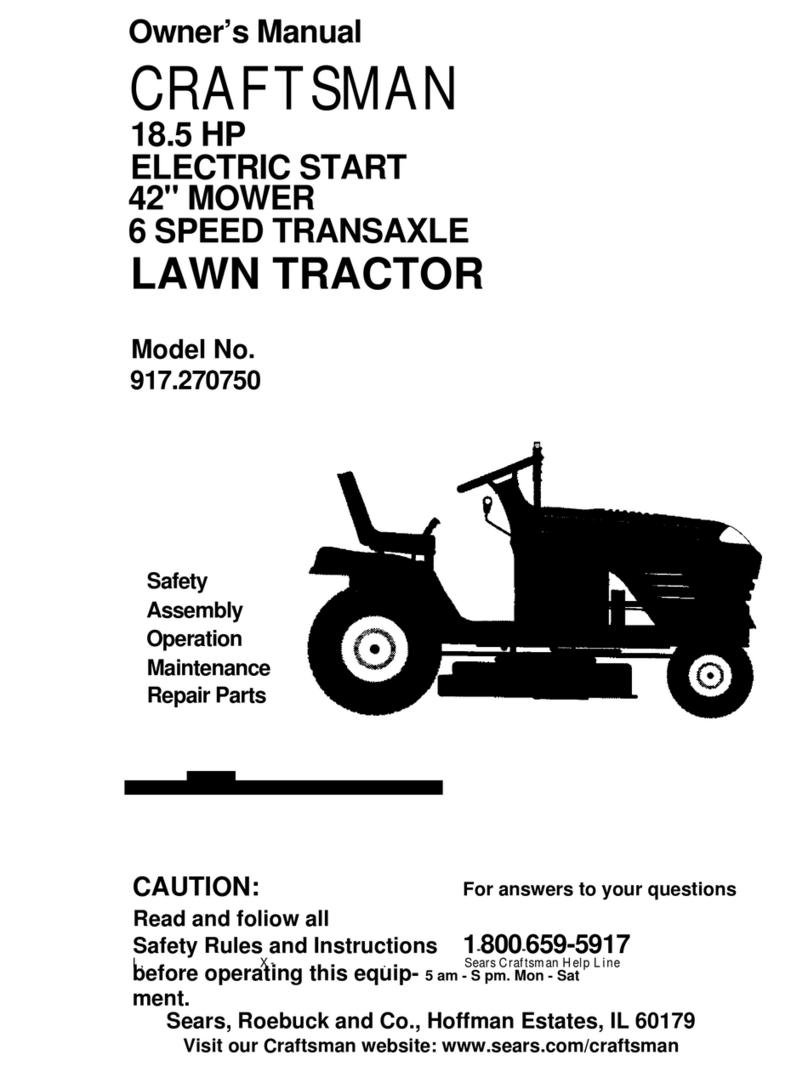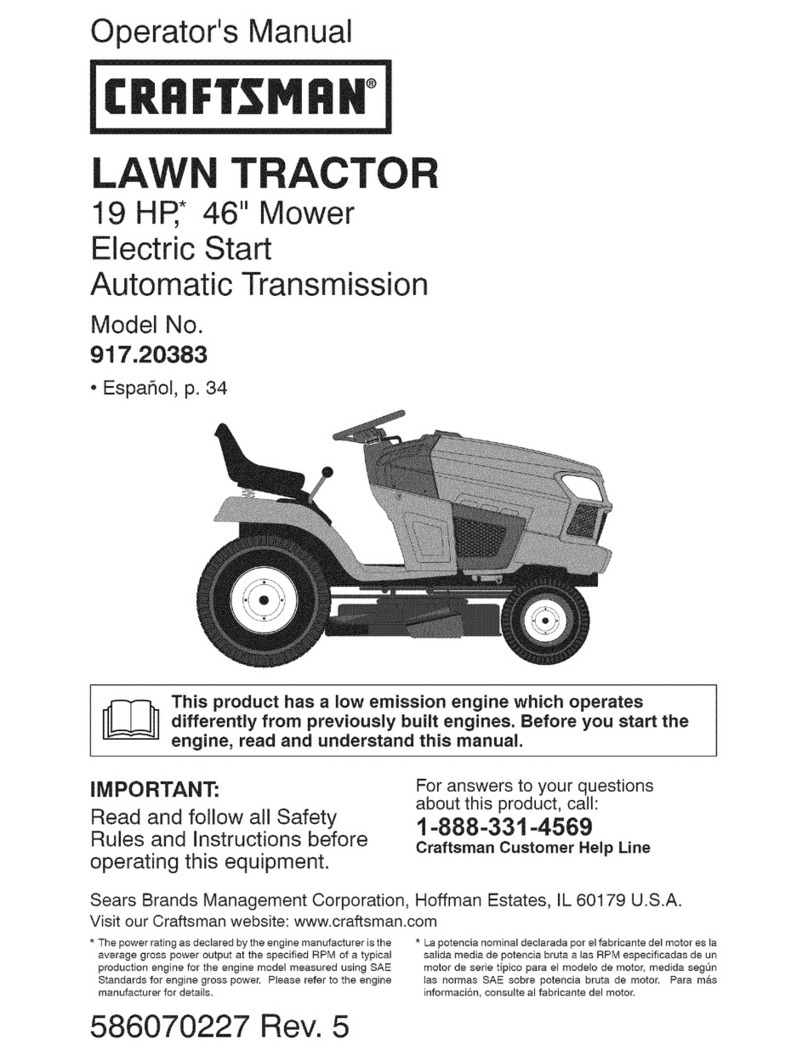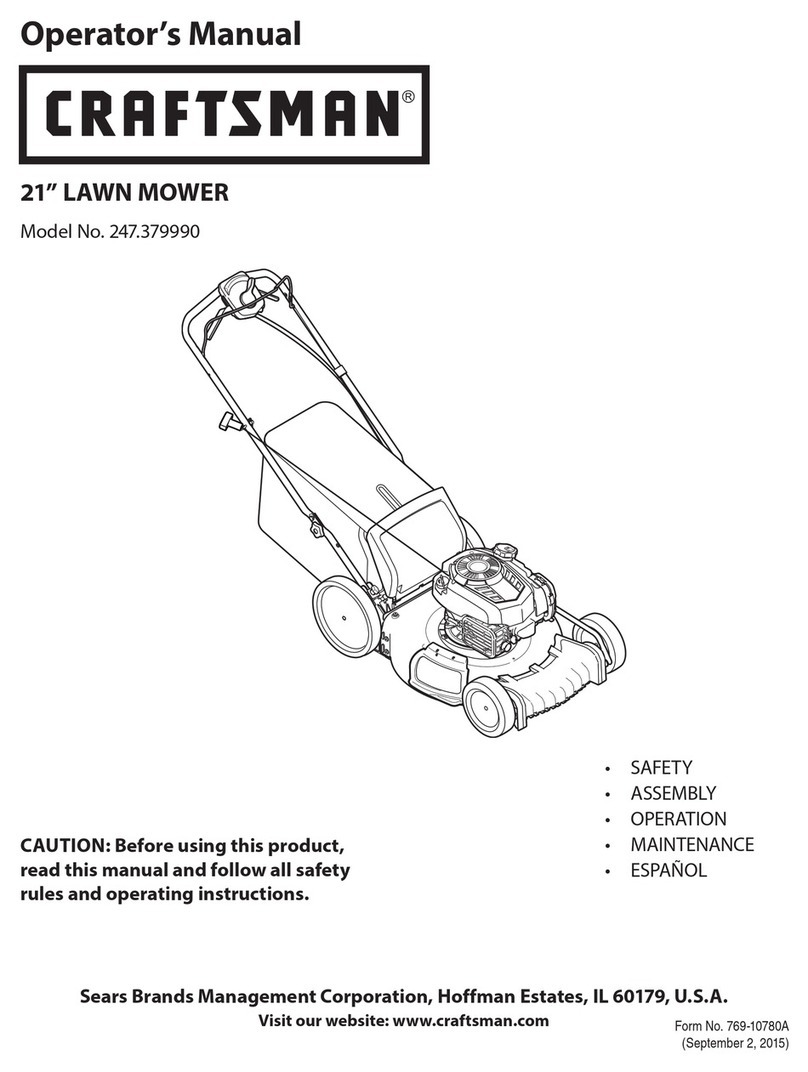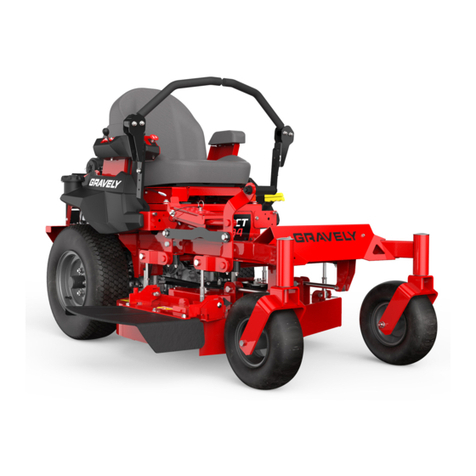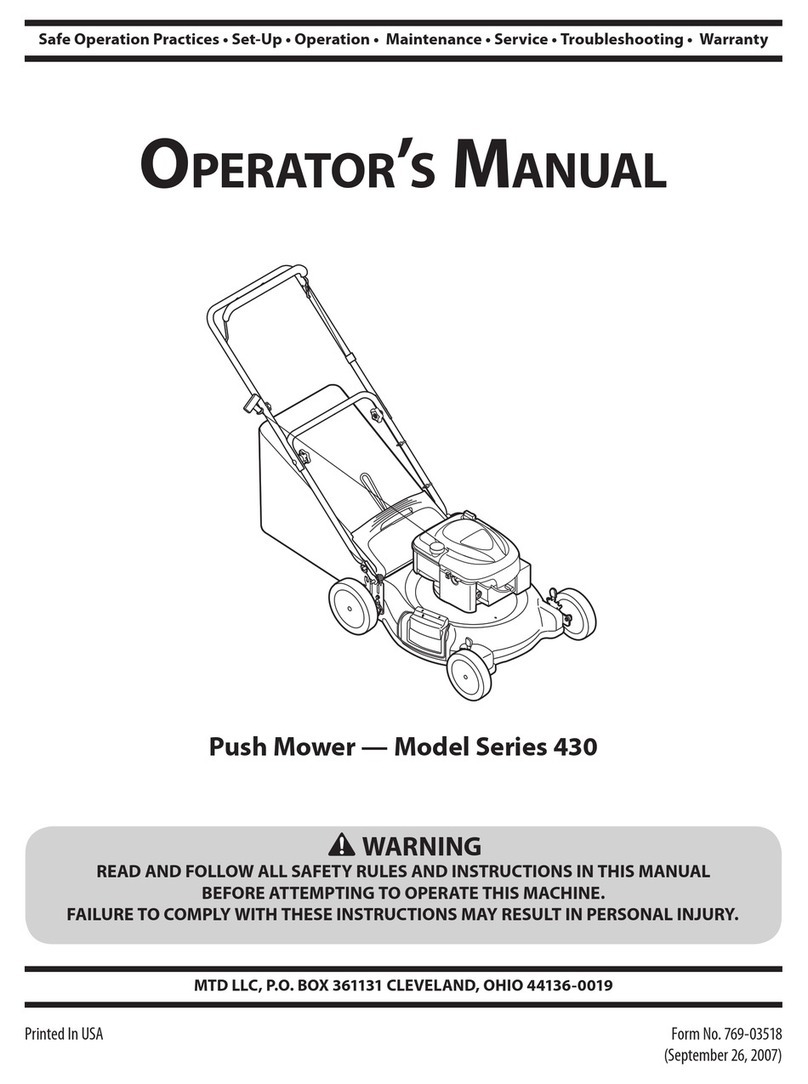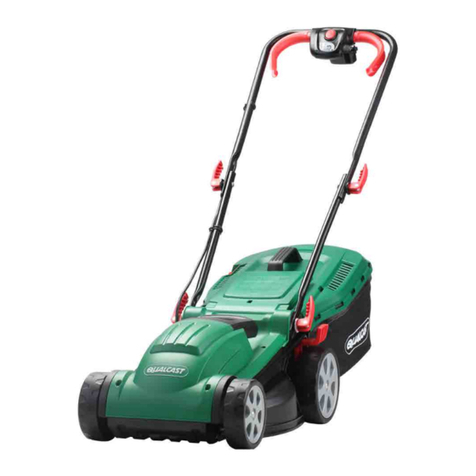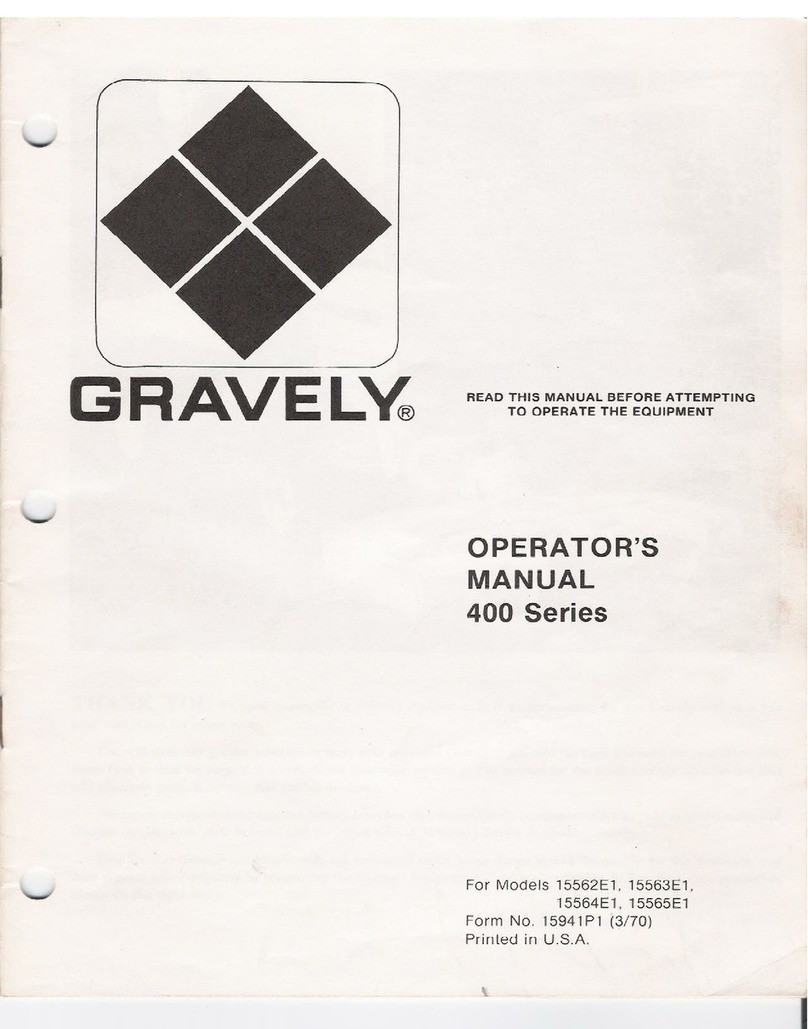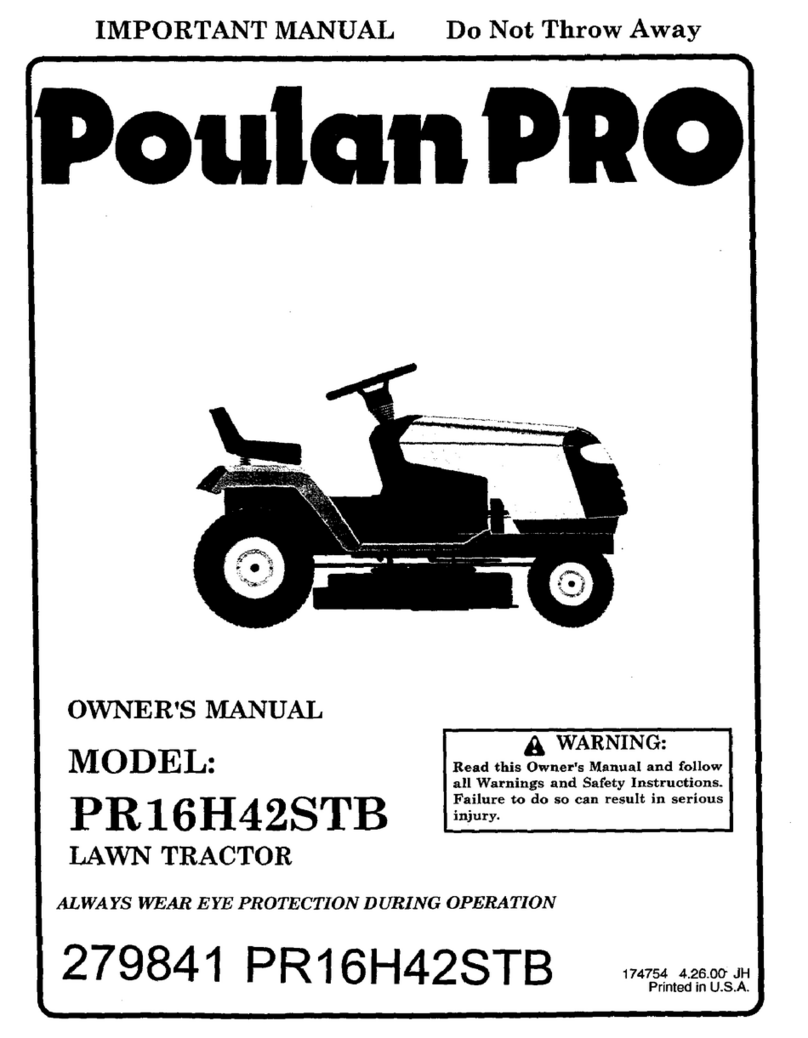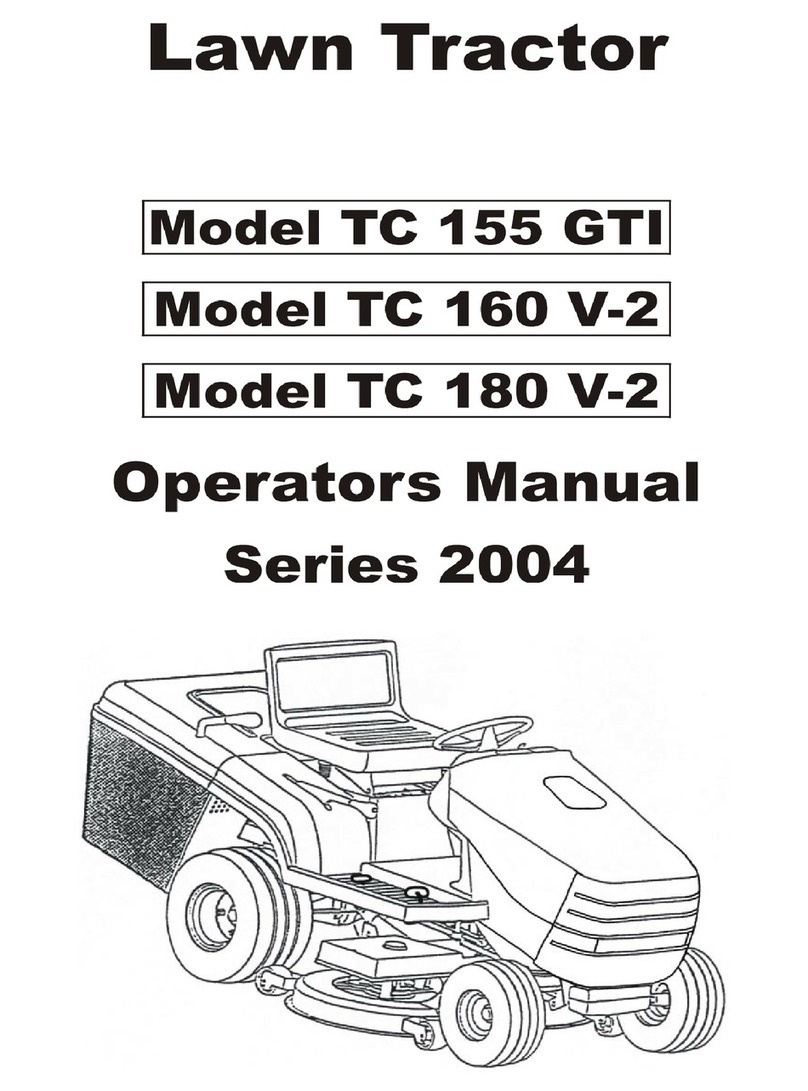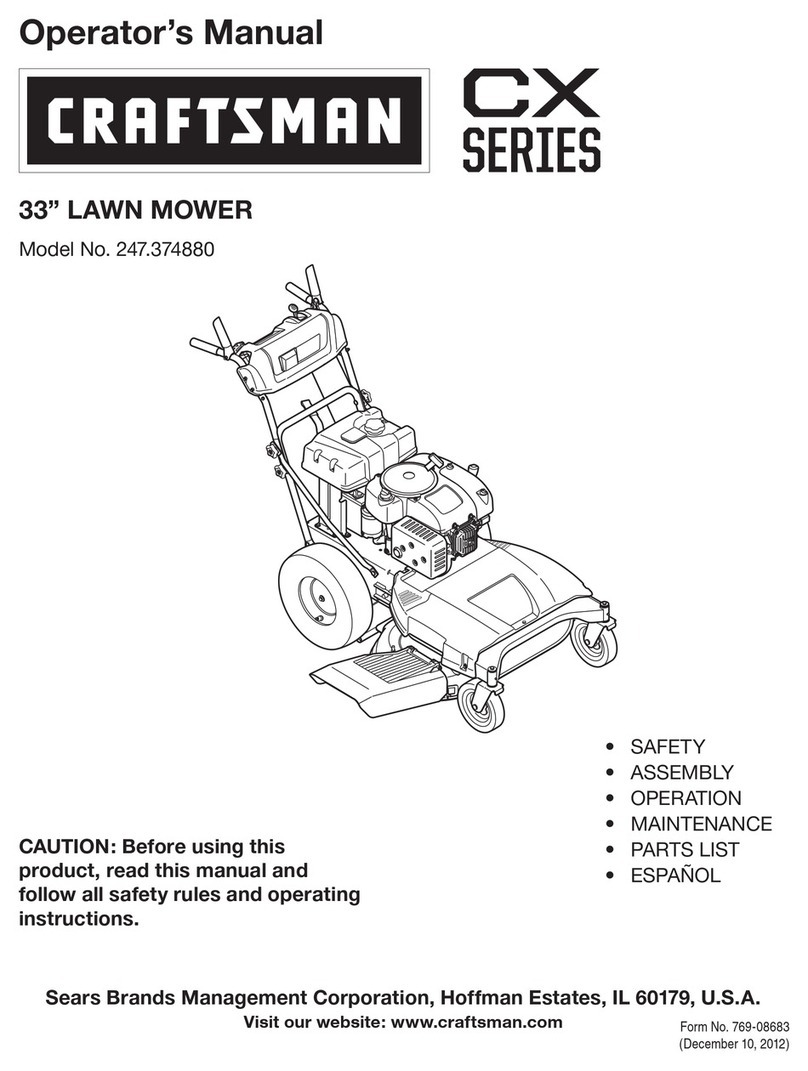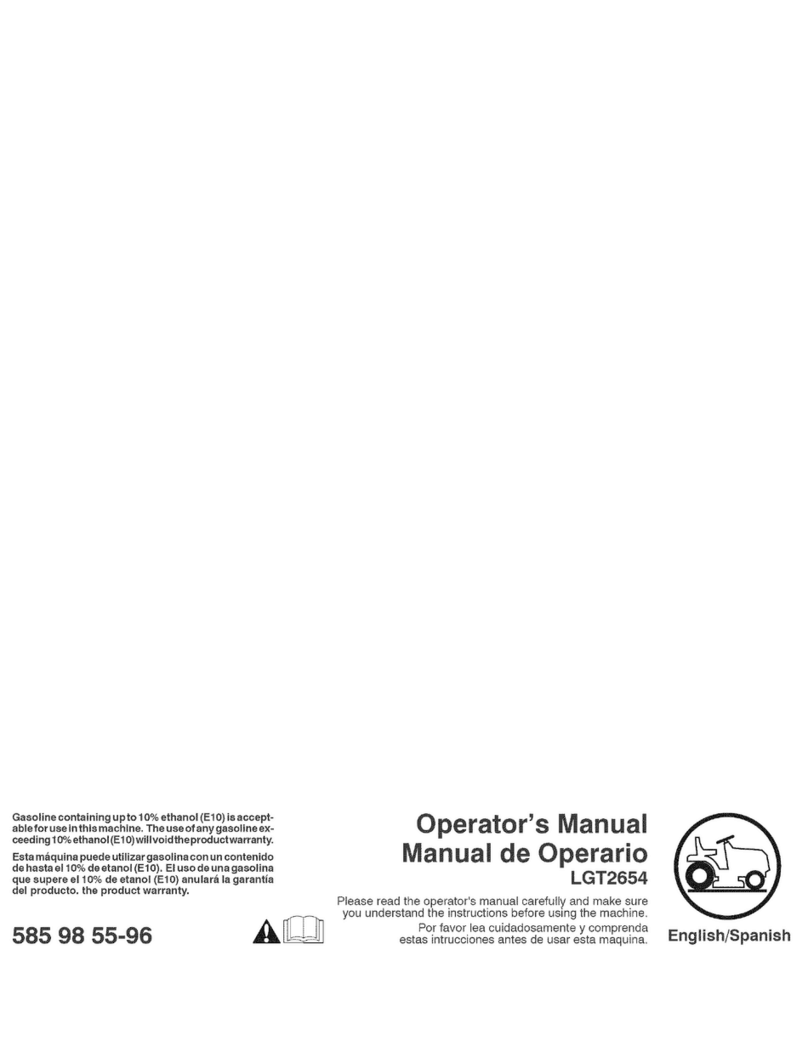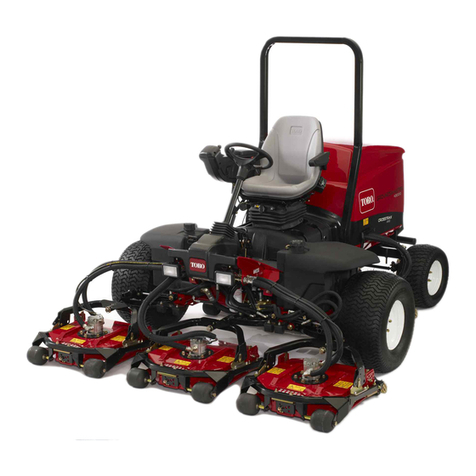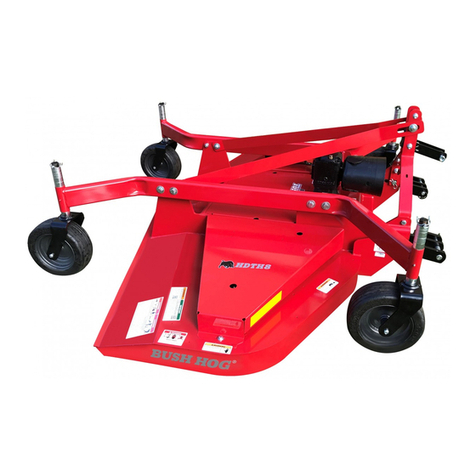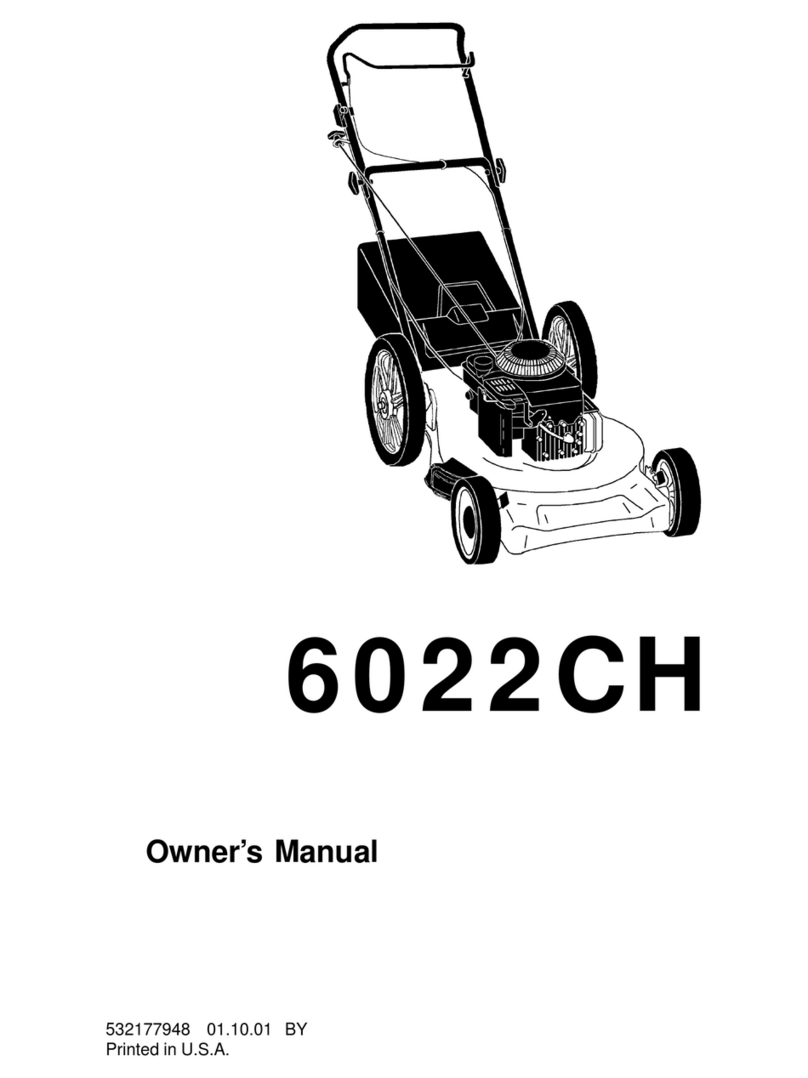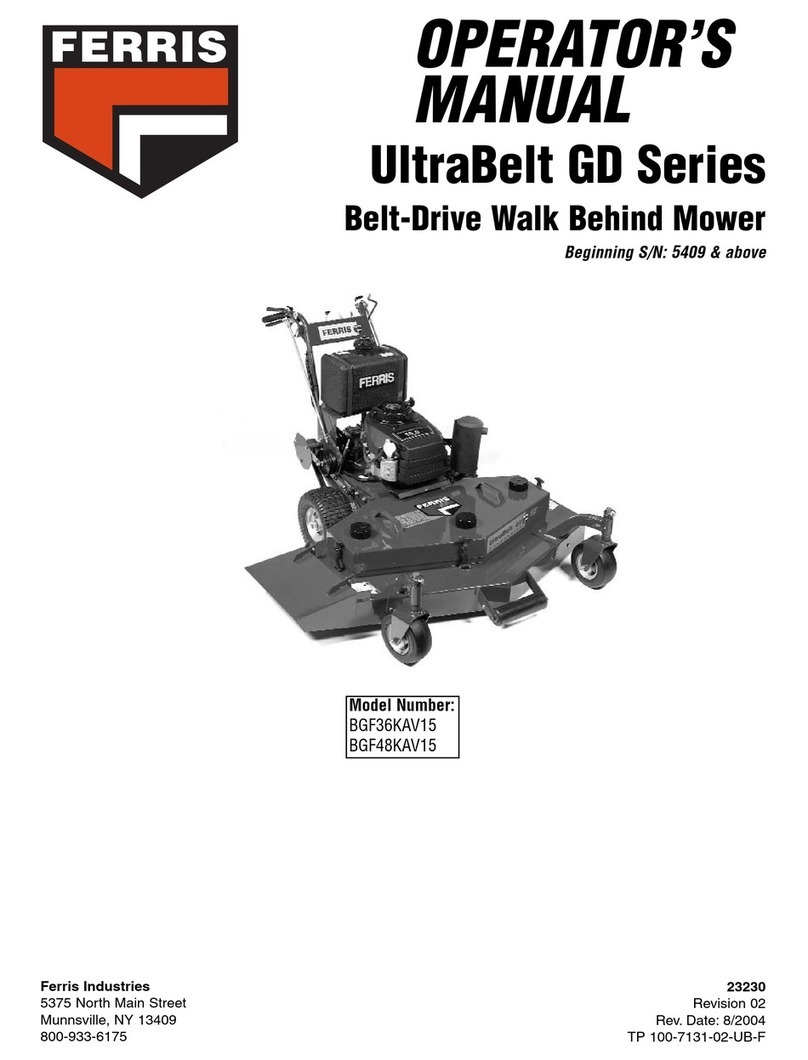Crafstman 917.28857 User manual

Para pedir servicio de reparación
a domicilio, y para ordenar piezas:
1-888-SU-HOGAR®
(1-888-784-6427)
Au Canada pour service en français:
1-800-LE-FOYERMC
(1-800-533-6937)
www.sears.ca
To purchase a protection agreement (U.S.A.)
or maintenance agreement (Canada) on a product serviced by Sears:
1-800-827-6655 (U.S.A.) 1-800-361-6665 (Canada)
Our Home
For repair of carry-in products like vacuums, lawn equipment,
and electronics, call or go on-line for the nearest
Sears Parts and Repair Center.
1-800-488-1222 Anytime, day or night (U.S.A. only)
www.sears.com
Your Home
For repair – in your home – of all major brand appliances,
lawn and garden equipment, or heating and cooling systems,
no matter who made it, no matter who sold it!
For the replacement parts, accessories and
owner’s manuals that you need to do-it-yourself.
For Sears professional installation of home appliances
and items like garage door openers and water heaters.
1-800-4-MY-HOME®Anytime, day or night
(1-800-469-4663) (U.S.A. and Canada)
www.sears.com www.sears.ca
Get it fixed, at your home or ours!
© Sears Brands, LLC
® Registered Trademark / TM Trademark / SM Service Mark of Sears Brands, LLC
® Marca Registrada / TM Marca de Fábrica / SM Marca de Servicio de Sears Brands, LLC
MC Marque de commerce / MD Marque déposée de Sears Brands, LLC
09.12.11 BD Printed in the U.S.A.
Gasoline containing up to 10% ethanol (E10) is acceptable for use in this machine.
The use of any gasoline exceeding 10% ethanol (E10) will void the product warranty.
Esta máquina puede utilizar gasolina con un contenido de hasta el 10% de etanol (E10). El
uso de una gasolina que supere el 10% de etanol (E10) anulará la garantía del producto.
Model No.
917.28857
LAWN TRACTOR
24.0 HP,*46" Mower
Electric Start
Automatic Transmission
• Español, p. 34
Operator's Manual
This product has a low emission engine which operates
differently from previously built engines. Before you start the
engine, read and understand this Operator’s Manual.
IMPORTANT:
Read and follow all Safety
Rules and Instructions before
operating this equipment.
For answers to your questions
about this product, Call:
1-800-659-5917
SEARS Craftsman Help Line
5 am - 5 pm, Mon - Sat
Visit our Craftsman website:www.sears.com/craftsman *As rated by the engine manufacturer
446244
Sears Brands Management Corporation, Hoffman Estates, IL 60179 U.S.A.

2
TABLE OF CONTENTS
WARRANTY
Warranty................................................ 2
Safety Rules .......................................... 3
Product Specifications........................... 6
Assembly/Pre-Operation ....................... 7
Operation............................................... 9
Maintenance Schedule........................ 16
Maintenance........................................ 16
Service and Adjustments..................... 21
Storage................................................ 27
Troubleshooting ................................... 28
Sears Service ........................Back Cover
Craftsman Riding Equipment Warranty
CRAFTSMAN FULL WARRANTY
FOR TWO YEARS from the date of purchase, all non-expendable parts of this riding equipment are
warranted against any defects in material or workmanship. A defective non-expendable part will
receive free in-home repair or replacement if repair is impossible.
FOR FIVE YEARS from the date of purchase, the frame and front axle of this riding equipment are
warranted against any defects in material or workmanship. A defective frame or front axle will receive
free in-home repair or replacement if repair is impossible.
FOR 90 DAYS from the date of purchase, the battery (an expendable part) of this riding equipment
is warranted against any defects in material or workmanship (our testing proves that it will not hold a
charge). A defective battery will receive free in-home replacement.
ADDITIONAL LIFETIME LIMITED WARRANTY on CAST IRON FRONT AXLE (if equipped)
FOR AS LONG AS IT IS USED by the original owner after the fifth year from the date of purchase, the
cast iron front axle (if equipped) of this riding equipment is warranted against any defects in material or
workmanship. With proof of purchase, a defective cast front axle will receive free in-home replacement.
WARRANTY SERVICE
For warranty coverage details to obtain free repair or replacement, call 1-800-659-5917 or visit the
web site: www.craftsman.com
In all cases above, if part repair or replacement is impossible, the riding equipment will be replaced
free of charge with the same or an equivalent model.
All of the above warranty coverage is void if this riding equipment is ever used while providing
commercial services or if rented to another person.
This warranty covers ONLY defects in material and workmanship. Warranty coverage does NOT
include:
• Expendable parts (except battery) that can wear out from normal use within the warranty period,
including but not limited to blades, spark plugs, air cleaners, belts, and oil filters.
• Standard maintenance servicing, oil changes, or tune-ups.
• Tire replacement or repair caused by punctures from outside objects, such as nails, thorns,
stumps, or glass.
• Tire or wheel replacement or repair resulting from normal wear, accident, or improper operation or
maintenance.
• Repairs necessary because of operator abuse, including but not limited to damage caused by
towing objects beyond the capability of the riding equipment, impacting objects that bend the
frame, axle assembly or crankshaft, or over-speeding the engine.
• Repairs necessary because of operator negligence, including but not limited to, electrical and
mechanical damage caused by improper storage, failure to use the proper grade and amount
of engine oil, failure to keep the deck clear of flammable debris, or failure to maintain the riding
equipment according to the instructions contained in the operator’s manual.
• Engine (fuel system) cleaning or repairs caused by fuel determined to be contaminated or oxidized
(stale). In general, fuel should be used within 30 days of its purchase date.
• Normal deterioration and wear of the exterior finishes, or product label replacement.
This warranty gives you specific legal rights, and you may also have other rights which vary from
state to state.
Sears Brands Management Corporation, Hoffman Estates, IL 60179
63
15 GRADOS MAX.
PLEGAR A LO LARGO DE LA LÍNEA PUNTEADA
ESTA ES UNA PENDIENTE DE 15 GRADOS
SOLAMENTE ANDE CUESTA ARRIBA O
CUESTA ABAJO Y NO ATRAVIESE EL CERRO
GUÍA SUGERIDA PARA MEDIR LAS PENDIENTES CON LA VISTA PARA UNA
OPERACIÓN SEGURA
ADVERTENCIA: Para evitar daños graves, haga funcionar su tractor arriba
y abajo de las pendientes, nunca transversalmente con respecto a las
pendientes. No cortar pendientes mayores de 15 grados. Haga los
virajes gradualmente para evitar volcarse o la pérdida de control.
Tenga mucho cuidado cuando cambie de dirección en las pendientes.
1. Plegar esta página a lo largo de la línea punteada arriba indicada.
2. Tener la página ante de sí mismos de modo que su borde izquierdo sea vertical
paralelo al tronco del árbol u otra estructura vertical.
3. Mirar a través del pliegue en dirección de la pendiente que se quiere medir.
4. Comparar el ángulo del pliegue con la pendiente del terreno.

62
NOTES/AVISO
3
I. GENERAL OPERATION
• Read, understand, and follow all instruc-
tions on the machine and in the manual
before starting.
• Do not put hands or feet near rotating
parts or under the machine. Keep clear
of the discharge opening at all times.
• Only allow responsible adults, who are
familiar with the instructions, to operate
the machine.
• Clear the area of objects such as rocks,
toys, wire, etc., which could be picked
up and thrown by the blades.
• Be sure the area is clear of bystanders
beforeoperating. Stopmachineifanyone
enters the area.
• Never carry passengers.
• Do not mow in reverse unless absolutely
necessary. Alwayslookdownandbehind
before and while backing.
• Never direct discharged material toward
anyone. Avoid discharging material
against a wall or obstruction. Material
may ricochet back toward the operator.
Stop the blades when crossing gravel
surfaces.
• Do not operate machine without the en-
tire grass catcher, discharge chute, or
othersafetydevicesinplaceandworking.
• Slow down before turning.
• Never leave a running machine unat-
tended. Always turn off blades, set
parking brake, stop engine, and remove
keys before dismounting.
• Disengage blades when not mowing.
Shut off engine and wait for all parts to
come to a complete stop before cleaning
themachine,removingthe grass catcher,
or unclogging the discharge chute.
• Operatemachineonly in daylightorgood
artificial light.
• Do not operate the machine while under
the influence of alcohol or drugs.
• Watch for traffic when operating near or
crossing roadways.
• Useextracarewhenloading or unloading
the machine into a trailer or truck.
• Alwaysweareyeprotectionwhen operat-
ing machine.
• Data indicates that operators, age 60
years and above, are involved in a large
percentage of riding mower-related inju-
ries. These operators should evaluate
their ability to operate the riding mower
safely enough to protect themselves and
others from serious injury.
• Followthe manufacturer’srecommenda-
tionfor wheel weights orcounterweights.
• Keep machine free of grass , leaves or
otherdebrisbuild-up which cantouchhot
exhaust / engine parts and burn. Do not
allow the mower to plow leaves or other
debris which can cause build-up to oc-
cur. Clean any oil or fuel spillage before
operating or storing the machine. Allow
machine to cool before storage.
DANGER: This cutting machine is capable of amputating hands and feet and
throwing objects. Failure to observe the following safety instructions could result
in serious injury or death.
WARNING: In order to prevent acciden-
tal starting when setting up, transporting,
adjusting or making repairs, always discon-
nect spark plug wire and place wire where
it cannot contact spark plug.
WARNING: Do not coast down a hill in
neutral, you may lose control of the tractor.
WARNING: Tow only the attachments
that are recommended by and comply with
specifications of the manufacturer of your
tractor. Use common sense when towing.
Operate only at the lowest possible speed
when on a slope. Too heavy of a load, while
on a slope, is dangerous. Tires can lose
traction with the ground and cause you to
lose control of your tractor.
WARNING: Engine exhaust, some of
its constituents, and certain vehicle compo-
nents contain or emit chemicals known to
the State of California to cause cancer and
birth defects or other reproductive harm.
WARNING: Battery posts, terminals and
related accessories contain lead and lead
compounds,chemicalsknown to the Stateof
California to cause cancer and birth defects
or other reproductive harm. Wash hands
after handling.
SAFETY RULES

4
II. SLOPE OPERATION
Slopes are a major factor related to loss of
control and tip-over accidents, which can
result in severe injury or death. Operation
on all slopes requires extra caution. If you
cannotbackupthe slope or ifyoufeeluneasy
on it, do not mow it.
• Mow up and down slopes, not across.
• Watch for holes, ruts, bumps, rocks, or
other hidden objects. Uneven terrain
could overturn the machine. Tall grass
can hide obstacles.
• Choose a low ground speed so that you
will not have to stop or shift while on the
slope.
• Do not mow on wet grass. Tires may lose
traction.
Always keep the machine in gear when
goingdown slopes. Do notshift to neutral
and coast downhill.
• Avoid starting, stopping, or turning on a
slope. Ifthetireslose traction, disengage
the blades and proceed slowly straight
down the slope.
• Keep all movement on the slopes slow
and gradual. Do not make sudden
changes in speed or direction, which
could cause the machine to roll over.
• Use extra care while operating machine
withgrasscatchersor other attachments;
they can affect the stability of the ma-
chine. Do no use on steep slopes.
• Do not try to stabilize the machine by
putting your foot on the ground.
• Do not mow near drop-offs, ditches,
or embankments. The machine could
suddenly roll over if a wheel is over the
edge or if the edge caves in.
III. CHILDREN
WARNING: CHILDREN CAN BE INJURED
BY THIS EQUIPMENT. The American Acade-
my of Pediatrics recommends that children
be a minimum of 12 year of age before op-
erating a pedestrian controlled lawn mower
and a minimum of 16 years of age before
operating a riding lawn mower.
Tragic accidents can occur if the operator
is not alert to the presence of children.
Children are often attracted to the machine
and the mowing activity. Never assume
that children will remain where you last
saw them.
• Keep children out of the mowing area
and in the watchful care of a responsible
adult other than the operator.
• Be alert and turn machine off if a child
enters the area.
• Before and while backing, look behind
and down for small children.
• Nevercarrychildren,evenwiththeblades
shutoff. Theymay falloffandbeseriously
injured or interfere with safe machine
operation.Childrenwho have been given
rides in the past may suddenly appear in
the mowing area for another ride and be
run over or backed over by the machine.
• Never allow children to operate the ma-
chine.
• Use extra care when approaching blind
corners, shrubs, trees, or other objects
that may block your view of a child.
IV. TOWING
• Tow only with a machine that has a hitch
designedfor towing. Donot attach towed
equipment except at the hitch point.
• Followthe manufacturer’srecommenda-
tionfor weight limits for towedequipment
and towing on slopes.
• Never allow children or others in or on
towed equipment.
• Onslopes,the weight ofthetowed equip-
ment may cause loss of traction and loss
of control.
• Travel slowly and allow extra distance to
stop.
V. SERVICE
SAFE HANDLING OF GASOLINE
To avoid personal injury or property dam-
age, use extreme care in handling gasoline.
Gasoline is extremely flammable and the
vapors are explosive.
• Extinguish all cigarettes, cigars, pipes,
and other sources of ignition.
• Use only approved gasoline container.
• Never remove gas cap or add fuel with
the engine running. Allow engine to cool
before refueling.
• Never fuel the machine indoors.
• Neverstorethe machine or fuelcontainer
where there is an open flame, spark, or
pilot light such as on a water heater or
other appliances.
• Never fill containers inside a vehicle or
on a truck or trailer bed with plastic liner.
Always place containers on the ground
away from your vehicle when filling.
SAFETY RULES
61
IDENTIFICACIÓN DE PROBLEMAS:
Vea la sección apropiada en el manual a menos que esté dirigido a un centro de servicio Sears.
PROBLEMA CAUSA CORRECCIÓN
Las luz (ces)
de lantera(s)
no funciona-
ndo
1. El interruptor está “APAGADO”(OFF). 1. “ENCIENDA” (ON) el interruptor.
2. Bombilla(s) o lámpara(s) quemada(s). 2.
Cambie la bombilla(s) o lámpara(s).
3. Interruptor de la luz fallado. 3. Revise/cambie el interruptor de la luz.
4. Alambrado suelto o dañado. 4.
Revise el alambrado y las conexiones.
5. Fusible quemado. 5. Cambie el fusible.
La batería
no carga
1.
Elemento(s) de la batería malo(s).
1. Cambie la batería.
2.
Malas conexiones de cables.
2. Revise/limpie todas las cables.
3. Regulador fallado (si equipado). 3. Cambie el regulador.
4. Alternador fallado. 4. Cambie el alternador.
Pérdida de
impulsión
1. El control de rueda libre está enla posición
“DESENGANCHADO” (disengaged). 1. Ponga el control de rueda libre enla
posición “ENGANCHADO”(disengaged).
2. Residuos es en de la placa de dirección. 2. Vea “LIMPIEZA” en la sección de Manteni-
mento de este manual.
3. La correa de impulsión de impulsión de
movimiento. 3. Reemplace la correa de movimien-to esta
gastada, dañada o rota.
4. Aireatrapado en la transporteo el servicio. 4. Purgue la transmisión.
5. Llave cuadrada de eje es ausente. 5. Vea “PARA REMOVER LAS RUEDAS”
en la sección de Servicio y Ajustes de
este manual.
El motor tien
“contraex-
plosiones”
cuando se
“APAGA”
1. Elcontrol dela aceleracióndel motorno fue
ajustadoen laposición de velocidadmedia
y máxima (rápida) antes de para el motor.
1. Mueva el control de la aceleración a la
posición de velocidad media y máxima
(rápida) antes de para el motor.
El tractor se
ponen mar-
cha atrás
1. El sistema de funcionamiento atrás (ROS)
no está "ON", cuando enganche la sega-
dora o otro accesorio.
1. Girar el ROS en la posición "ON".Vea la
sección de operación.

60
IDENTIFICACIÓN DE PROBLEMAS:
Vea la sección apropiada en el manual a menos que esté dirigido a un centro de servicio Sears.
PROBLEMA CAUSA CORRECCIÓN
Pérdida de
fuerza
(sigue)
9. Agua en el combustible. 9. Vaciarelestanquedecombustibleyelcarbu-
rador,vuelva allenar elestanque congaso-
linanueva ycambie elfiltro decombustible.
10. Alambrado de la bujía suelto. 10. Conecte y apriete el alambre de la bujía.
11. Rejilla/aletas de aire del motor sucias. 11. Limpie las rejilla/aletas de aire del motor.
12. Silenciador sucio/taponado. 12. Limpie/cambie el silenciador.
13. Alambrado suelto o dañado. 13. Revise todo el alambrado.
14. Carburador desajustado. 14. Vea “PARA AJUSTAREL CARBURADOR”
en la sección de Servicio y Ajustes.
15. Válvulas del motor desajustadas. 15. Pongase en contacto con un centro de
servicio cualificado "SEARS".
Vibración
excesiva
1. Cuchilla desgastada, doblada o suelta. 1. Cambie la cuchilla. Apriete el perno de
la cuchilla.
2. Mandril de la cuchilla doblado. 2. Cambie la mandril de la cuchilla.
3. Parte(s) suelta(s)/dañada(s). 3. Apriete la(s) parte(s). Cambie las partes
dañadas.
El motor conti-
núa funcionando
cuando el op-
erador se baja
delasientocon
el embrague
del accesorio
enganchado
1. Sistema de control que exige la presencia
del operador –seguridad fallado. 1. Revise el alambrado, los interruptores
y la conexiones.Si no están correctas,
Pongase en contacto con un centro de
servicio cualificado "SEARS".
El corte
disparejo
1. Cuchilla desgastada, doblada o suelta. 1. Cambie la cuchilla. Apriete el perno de
la cuchilla.
2. El conjunto segador no estánivelado. 2. Nivele el conjunto segador.
3. Acumulación de césped, hojas y basura
debajo de la segadora. 3. Limpie la parte inferior de la cajade la
segadora.
4. Mandril de la cuchilla doblado. 4. Cambie la mandril de la cuchilla.
5. Los agujeros de ventilación del conjunto
segador taponadosdebido a la acumu-
lación de
cé-sped, hojas y basura
alred-
edorde los mandriles.
5. Limpie alrededor de los mandriles para
abrir los de ventilación.
Las cuchil-
las segado-
ras no rotan
1. Obstrucciónenelmecanismodelembrague. 1. Remueva la obstrucción.
2. Lacorrea deimpulsión de lasegadora está
desgastada/dañada. 2. Cambie la correa de impulsión de la
segadora.
3. Polea de guía atascada. 3. Cambie la polea de guía.
4. Mandril de la cuchilla atascado. 4. Cambie la mandril de la cuchilla.
Mala des-
carga del
césped
1. Velocidad del motor muy lenta. 1. Ponga el control de la aceleración en la
posición de “RÁPIDO” (fast).
2. Velocidad de recorrido demasiado rápida. 2. Cambie a una velocidad más lenta.
3. Césped mojado. 3. Permita que se seque el céspedantes
de segar.
4. El conjunto segador no estánivelado. 4. Nivele el conjunto segador.
5. Presión de aire de las llantas baja o
dispareja. 5. Revise las llantas para verificarque tienen
la presión de aire.
6. Cuchilla desgastada, doblada o suelta. 6. Cambie/afile la cuchilla. Apriete el perno
de la cuchilla.
7. Acumulación de césped, hojas y basura
debajo de la segadora. 7. Limpie la parte inferior de la cajade la
segadora.
8. Lacorrea deimpulsión de lasegadora está
desgastada o desajustada. 8. Cambie/ajuste la correa de impulsión de
la segadora.
9. Las cuchillas están mal coninstaladas. 9.
Vuelva a instalar las cuchillas elborde afilado
hacia abajo.
10. Cuchillas inadecuadas en uso. 10. Cambie por las cuchillas enumeradas en
este manual.
11. Los agujeros de ventilación del conjunto
agujeros segador taponados debido a la
acumulación de césped, hojas y basura
alrededor de los mandriles.
11. Limpie alrededor de los mandriles para
abrir los de ventilación.
5
• Remove gas-powered equipment from
the truck or trailer and refuel it on the
ground. If this is not possible, then refuel
suchequipmentwithaportablecontainer,
rather than from a gasoline dispenser
nozzle.
• Keep the nozzle in contact with the rim
of the fuel tank or container opening at
all times until fueling is complete. Do not
use a nozzle lock-open device.
• Iffuel is spilled on clothing,change cloth-
ing immediately.
• Never overfill fuel tank. Replace gas cap
and tighten securely.
GENERAL SERVICE
• Never operate machine in a closed area.
• Keepallnutsandbolts tight tobesure the
equipment is in safe working condition.
• Maintainorreplacesafety and instruction
labels, as necessary.
• Be sure the area is clear of bystanders
beforeoperating. Stopmachineifanyone
enters the area.
• Never carry passengers.
• Do not mow in reverse unless absolutely
necessary.Alwayslookdown and behind
before and while backing.
• Never carry children, even with the
blades shut off. They may fall off and
be seriously injured or interfere with safe
machine operation. Children who have
beengivenridesinthepastmaysuddenly
appear in the mowing area for another
ride and be run over or backed over by
the machine.
• Keep children out of the mowing area
and in the watchful care of a responsible
adult other than the operator.
• Nevertamperwith safety devices.Check
their proper operation regularly.
• Keep machine free of grass, leaves, or
other debris build-up. Clean oil or fuel
spillageand remove anyfuel-soakedde-
bris. Allowmachinetocoolbeforestoring.
• If you strike a foreign object, stop and
inspectthemachine.Repair,ifnecessary,
before restarting.
• Never make any adjustments or repairs
with the engine running.
• Checkgrasscatchercomponentsandthe
discharge chute frequently and replace
withmanufacturer’srecommendedparts,
when necessary.
• Mowerblades are sharp. Wrap theblade
or wear gloves, and use extra caution
when servicing them.
• Checkbrakeoperation frequently. Adjust
and service as required.
• Be alert and turn machine off if a child
enters the area.
• Before and while backing, look behind
and down for small children.
• Mow up and down slopes (15° Max), not
across.
• Choose a low ground speed so that you
will not have to stop or shift while on the
slope.
• Avoid starting, stopping, or turning on a
slope. Ifthetireslose traction, disengage
the blades and proceed slowly straight
down the slope.
• If machine stops while going uphill,
disengage blades, shift into reverse and
back down slowly.
• Do not turn on slopes unless necessary,
and then, turn slowly and gradually
downhill, if possible.
• Whenloading or unloading thismachine,
do not exceed the maximum recom-
mended operation angle of 15°.
SAFETY RULES

6
CUSTOMER RESPONSIBILITIES
• Read and observe the safety rules.
• Follow a regular schedule in maintaining,
caring for and using your tractor.
• Follow instructions under “Maintenance”
and “Storage” sections of this manual.
• Wear proper Personal Protective Equip-
ment (PPE) while operating this machine,
including (at a minimum) sturdy footwear,
eyeprotection,andhearing protection. Do
notmowinshortsand/oropentoedfootwear.
• Alwayslet someone knowyou are outside
mowing.
WARNING: Thistractoris equipped with
an internal combustion engine and should
not be used on or near any unimproved
forest-covered, brush-covered or grass-
covered land unless the engine’s exhaust
system is equipped with a spark arrester
meeting applicable local or state laws (if
any). If a spark arrester is used, it should
be maintained in effective working order by
the operator.
CONGRATULATIONS onyour purchase of
a new tractor. It has been designed, engi-
neeredandmanufacturedto give youthebest
possible dependability and performance.
Shouldyouexperienceanyproblemyoucan-
not easily remedy, please contact a Sears or
otherqualifiedservice center. Wehavecom-
petent, well-trained representatives and the
proper tools to service or repair this tractor.
Please read and retain this manual. The
instructions will enable you to assemble
and maintain your tractor properly. Always
observe the “SAFETY RULES”.
Inthestateof California the aboveisrequired
by law (Section 4442 of the California Public
Resources Code). Other states may have
similar laws. Federal laws apply on federal
lands. A spark arrester for the muffler is
availablethroughyournearest Sears service
center (See REPAIR PARTS manual).
REPAIR PROTECTION AGREEMENTS
Congratulations on making a smart pur-
chase. Your new Craftsman® product is
designed and manufactured for years of
dependable operation. But like all products,
itmay require repairfrom time totime. That’s
whenhavinga Repair ProtectionAgreement
can save you money and aggravation.
Purchase a Repair Protection Agreement
now and protect yourself from unexpected
hassle and expense.
Here’s what’s included in the Agreement:
• Expertservicebyour12,000professional
repair specialists.
• Unlimitedserviceand no chargeforparts
and labor on all covered repairs.
• Product replacement if your covered
product can’t be fixed.
• Discount of 10% from regular price of
service and service-related parts not
covered by the agreement; also, 10% off
regular price of preventive maintenance
check.
• Fast help by phone – phone support
from a Sears representative on products
requiringin-homerepair,plusconvenient
repair scheduling.
Onceyoupurchase the Agreement, asimple
phone call is all that it takes for you to sched-
uleservice.Youcancallanytimedayor night,
or schedule a service appointment online.
Sears has over 12,000 professional repair
specialists, who have access to over 4.5
million quality parts and accessories. That’s
thekind ofprofessionalism you can count on
to help prolong the life of your new purchase
for years to come. Purchase your Repair
Protection Agreement today!
Some limitations and exclusions apply.
Forprices andadditional information call
1-800-827-6655.
SEARS INSTALLATION SERVICE
For Sears professional installation of home
appliances, garage door openers, water
heaters, and other major home items, in the
U.S.A. call 1-800-4-MY-HOME®
PRODUCT SPECIFICATIONS
Gasoline Capacity
and type: 3.0 Gallons/11,35 L
Regular Unleaded
Oil Type:
(API: SG-SL) SAE 30 (above 32°F/0°C)
SAE 5W30 (below 32°F/0°C)
Oil Capacity: W/ Filter: 64 Oz./1,96 L
W/out Filter: 60 Oz./1,77 L
Spark Plug: Champion QC12YC
(Gap: .040"/1.02 mm)
Ground Speed
(Mph/Kph): Forward: 0 - 5.2/8,4
Reverse: 0 - 2.9/4,7
Charging
System: 3 Amps Battery
5 Amps Headlights
Battery: Amp/Hr: 28
Min. CCA: 230
Case size: U1R
Blade Bolt Torque: 45-55 Ft. Lbs./62-75 Nm
59
IDENTIFICACIÓN DE PROBLEMAS:
Vea la sección apropiada en el manual a menos que esté dirigido a un centro de servicio Sears.
PROBLEMA CAUSA CORRECCIÓN
No arranca 1. Sin combustible. 1. Llene el estanque de combustible.
2. Motor sin la “ESTRANGULACIÓN”
(CHOKE) adecuada. 2. Vea “PARA HACER ARRANCAR EL MO-
TOR” en la sección de operación.
3. Motor ahogado. 3. Espere varios minutos antes detratar de
arrancar.
4. Bujía mala. 4. Cambie la bujía.
5. Filtro de aire sucio. 5. Limpie/cambie el filtro de aire.
6. Filtro de combustible sucio. 6. Cambie el filtro de combustible.
7. Agua en el combustible. 7. Vaciar el estanque de combustible y el
carburador, vuelva a llenar el estanque
con gasolina nueva cambie el filtro de
combustible.
8. Alambrado suelto o dañado. 8. Revise todo el alambrado.
9. Carburador desajustado. 9.
Vea “PARA AJUSTAR
EL CARBURADOR”
en la sección de Servicio y Ajustes.
10. Válvulas del motor desajustadas. 10. Pongase en contacto con un centro de
servicio cualificado "SEARS".
Difícil de
arrancar
1. Filtro de aire sucio. 1. Limpie/cambie el filtro de aire.
2. Bujía mala. 2. Cambie la bujía.
3. Batería baja o descargada. 3.
Vuelva a cargar o cambie la batería.
4. Filtro de combustible sucio. 4. Cambie el filtro de combustible.
5. Combustible rancio o sucio. 5. Vaciar elestanque decombustible yvuelva
a llenarlo con gasolina nueva.
6. Alambrado suelto o dañado. 6. Revise todo el alambrado.
7. Carburador desajustado. 7. Vea “PARA AJUSTAREL CARBURADOR”
en la sección de Servicio y
Ajustes.
8.
Válvulas del
motor desajustadas. 8. Pongase en contacto con un centro de
servicio cualificado "SEARS".
El motor no
la vuelta
1. Pedal del freno no presionado. 1. Presione el pedal del freno.
2. Elembraguedelaccesorioestáenganchado. 2. Desenganche el embrague del accesorio.
3. Batería baja o descargada. 3.
Vuelva a cargar o cambie la batería.
4. Fusible quemado. 4. Cambie el fusible.
5.
Terminales de la batería corroídos.
5. Limpie los terminales de la batería.
6. Alambrado suelto o dañado. 6. Revise todo el alambrado.
7. Interruptor de la ignición fallado. 7. Revise/cambieel interruptor dela ignición.
8. Solenoide o arrancador fallados. 8. Revise/cambie el solenoide o arrancador.
9. Interruptor(es) que exige(n) la presencia
del operador fallado. 9. Pongase en contacto con un centro de
servicio cualificado "SEARS".
El motor
suena pero
no arranca
1. Batería baja o descargada 1.
Vuelva a cargar o cambie la bate
ría.
2.
Terminales de la batería corroídos.
2.
Limpie los terminales de la batería.
3. Alambrado suelto o dañado. 3. Revise todo el alambrado.
4. Solenoide o arrancador fallados. 4. Revise/cambie el solenoide o arrancador.
Pérdida de
fuerza
1.
Corta mucho césped, muy rápido.
1. Elevelaaltura decorte/reduzcala velocidád
2. Aceleración en la posición de
“ESTRAN-
GULACIÓN” (CHOKE).
2. Ajuste el control de la aceleración.
3. Acumulación de césped, hojas y basura
debajo de la segadora. 3. Limpie la parte inferior de la cajade la
segadora.
4. Filtro de aire sucio. 4. Limpie/cambie el filtro de aire.
5. Nivel de aceite bajo/aceite sucio. 5. Revise el nivel de aceite/cambie el aceite.
6. Bujía fallada. 6. Limpie y vuelva a ajustar la abertura o
cambie la bujía.
7. Filtro de combustible sucio. 7. Cambie el filtro de combustible.
8. Combustible rancio o sucio. 8. Vaciar elestanque decombustible yvuelva
a llenarlo con gasolina nueva.

58
ALMACENAMIENTO
Inmediatamente prepare su tractor para el alma-
cenamiento al final de la temporada o si el tractor
no se va a usar por 30 días o más.
ADVERTENCIA: Nunca almacene el tractor
con gasolina en el estanque dentro de un edificio
en donde los gases pueden alcanzar una llama
expuesta o una chispa. Permita que el motor se
enfríe antes de almacenarlo en cualquier recinto
privado.
TRACTOR
Cuando el tractor se va a almacenar por cierto
período de tiempo, límpiela cuidadosamente,
quite toda la mugre, la grasa, las hojas, etc.
Guárdela en una área limpia y seca.
1. Limpie todo el tractor (vea “LIMPIEZA” en la
sección de Mantenimiento en este manual).
2. Inspeccione y cambie las correas, si es nece-
sario (vea las instrucciones para el cambio de
las correas en la sección de Servicio y Ajustes
de este manual).
3. Lubríquelo, según se muestra en la sección
de Mantenimiento de este manual.
4. Asegúrese que todas las tuercas, los pernos y
los tornillos estén sujetados en forma segura.
Inspeccione las partes movibles para verificar
si hay daño, rotura o desgaste. Cámbielas si
es necesario.
5. Retoque todas superficies pintadas oxidadas
o picadas; aplique lija antes de pintar.
BATERÍA
• Cargue la batería completamente antes de
guardarla.
• Después de cierto período de tiempo en alma-
cenamiento, la batería puede necesitar volver
a cargarse.
• Para ayudar a evitar la corrosión y las fugas
de potencia durante largos períodos de alma-
cenamiento, se deben desconectar los cables
de la batería y se debe limpiar cuidadosamen-
te (vea “PARA LIMPIAR LA BATERÍA Y LOS
TERMINALES” en la sección de Mantenimien-
tode este manual).
• Después de limpiarla, deje los cables desco-
nectados y póngalos en donde no puedan
entrar en contacto con los terminales de la
batería.
• Si se remueve la batería del tractor para el
almacenamiento, no la guarde directamente
sobre concreto o sobre superficies húmedas.
MOTOR
SISTEMA DE COMBUSTIBLE
IMPORTANTE: Es important evitar que se
forman depositos de goma en partes funda-
mentales del sistema de combus-tible tales
como el carburador, el filtro del combustible,
la manguera del combustibles mezclados con
alcohol (conocido como gasohol o que tienen
etanol o metanol) pueden atraer humedad, lo
que conduce a la separación y a la formación
de acudos durante elalmacenamiento. La gaso-
lina acidica puede dañar el sistema de combus-
tible de un motor durante el periodo de almace-
namiento.
• Vaciar el depósito del carburante poniendo en
marcha el motor y dejándolo funcionar hasta
que el carburante termine el carburador esté
vacío.
• Nunca use los productos para limpieza del
carburador o del motor en el estanque de
combustible pues se pueden producir daños
permanentes.
• Use combustible nuevo la próxima temporada.
AVISO: El estabilizador de combustible es una
alternativa aceptable para reducir a un mínimo
la formación de depósitos de goma en el com-
bustible durante el período de almacenamiento.
Agregue estabilizador a la gasolina en el es-
tanque de combustible o en el envase para el
almacenamiento. Siempre siga la proporción de
mezcla que se encuentra en el envase del estabi-
lizador. Haga funcionar el motor por lo menos 10
minutos después de agregar el estabilizador, para
permitir que éste llegue al carburador. No vaciar la
gasolina del estanque de gasolina y el carburador
si se está usando estabilizador de combustible.
ACEITE DEL MOTOR
Drene el aceite (con el motor caliente) y cámbielo
con aceite de motor limpio. (Vea “MOTOR” en
la sección de Mantenimiento” de este manual.)
CILINDRO(S)
1. Remueva la(s) bujía(s).
2. Vacíe una onza de aceite a través del
agujero(s) de la bujía en el cilindro(s).
3. Gire la llave de ignición a la posición de “Ar-
ranque” (Start), por unos cuantos segundos
para distribuir el aceite.
4. Cambie por bujía(s) nueva(s).
OTROS
• No guarde la gasolina de una temporada a la
otra.
• Cambie el envase de la gasolina si se emp-
ieza a oxidar. La oxidación y/o la mugre en su
gasolina producirán problemas.
• Si es posible, guarde su unidad en un recinto
cerrado y cúbrala para protegerla contra el
polvo y la mugre.
• Cubra su unidad con un forro protector ad-
ecuado que no retenga la humedad. No use
plástico. El plástico no puede respirar, lo que
permite la formación de condensación, lo que
producirá la oxidación de su unidad.
IMPORTANTE: Nunca cubra el tractor mientras
el motor y las areas de escape todavia estan
calientes.
7
Keys
(2) Keys
Slope Sheet
UNASSEMBLED PARTS
Your new tractor has been assembled at the factory with the exception of those parts left
unassembled for shipping purposes.
ASSEMBLY/PRE-OPERATION
ADJUST SEAT
1. Sit in seat.
2. Liftup adjustment lever (A)and slide seat
until a comfortable position is reached
which allows you to press clutch/brake
pedal all the way down.
3. Release lever to lock seat in position.
TOOLS REQUIRED FOR ASSEMBLY
A socket wrench set will make assembly
easier. Standard wrench sizes are listed.
(1) 1/2" wrench Tire pressure gauge
(2) 7/16" wrenches Utility knife
Pliers
When right or left hand is mentioned in this
manual,itmeanswhenyouareintheoperating
position (seated behind the steering wheel).
TO REMOVE TRACTOR FROM
CARTON
UNPACK CARTON
• Remove all accessible loose parts and
parts cartons from carton .
• Cut along dotted lines on all four panels
of carton. Remove end panels and lay
side panels flat.
• Check for any additional loose parts or
cartons and remove.
BEFORE REMOVING TRACTOR
FROM SKID
02931
LABEL
TO CHECK BATTERY
1. Lift hood to raised position.
NOTE: If this battery is put into service after
month and year indicated on label (label is
located between terminals) charge battery
for minimum of one hour at 6-10 amps. (See
"BATTERY" in Maintenance section of this
manual for charging instructions).
• For battery and battery cable installation
see "REPLACING BATTERY" in the
"Serviceand Adjustments" section inthis
manual.
A

8
CHECK TIRE PRESSURE
The tires on your tractor were overinflated at
the factory for shipping purposes. Correct
tire pressure is important for best cutting
performance.
• Reduce tire pressure to PSI shown on
tires.
CHECK DECK LEVELNESS
For best cutting results, mower housing
should be properly leveled. See “TO LEVEL
MOWER” in the Service and Adjustments
section of this manual.
✓CHECKLIST
Before you operate your new tractor, we
wish to assure that you receive the best
performance and satisfaction from this
Quality Product.
Please review the following checklist:
✓All assembly instructions have been com-
pleted.
✓No remaining loose parts in carton.
✓Battery is properly prepared and
charged.
✓Seatisadjustedcomfortablyand tightened
securely.
✓All tires are properly inflated. (For ship-
ping purposes, the tires were overinflated
at the factory).
✓Be sure mower deck is properly leveled
side-to-side/front-to-rear for best cutting
results. (Tires must be properly inflated
for leveling).
✓Check mower and drive belts. Be sure
they are routed properly around pulleys
and inside all belt keepers.
✓Check wiring. See that all connections
are still secure and wires are properly
clamped.
✓Before driving tractor, be sure freewheel
control is in “transmission engaged”
position (see “TO TRANSPORT” in the
Operation section of this manual).
Whilelearninghowtouseyourtractor, pay ex-
tra attention to the following important items:
✓Engine oil is at proper level.
✓Fuel tank is filled with fresh, clean, regular
unleaded gasoline.
✓Become familiar with all controls, their lo-
cation and function. Operate them before
you start the engine.
✓Be sure brake system is in safe operating
condition.
✓ Be sure Operator Presence System and
Reverse Operation System (ROS) are
working properly (See the Operation and
Maintenance sections in this manual).
✓Itisimportanttopurgethetransmissionbefore
operating your tractor for the first time. Fol-
lowproperstartingandtransmissionpurging
instructions (See “TO START ENGINE” and
“PURGETRANSMISSION”intheOperation
section of this manual).
CHECK FOR PROPER POSITION OF
ALL BELTS
See the figures that are shown for replacing
motion and mower blade drive belts in the
ServiceandAdjustmentssection of this man-
ual. Verify that the belts are routed correctly.
CHECK BRAKE SYSTEM
After you learn how to operate your tractor,
checkto see that thebrake is operating prop-
erly. See“TOCHECKBRAKE” in the Service
and Adjustments section of this manual.
NOTE: You may now roll your tractor off the
skid.Followthe appropriateinstructionbelow
to remove the tractor from the skid.
WARNING: Before starting, read, un-
derstand and follow all instructions in the
Operation section of this manual. Be sure
tractor is in a well-ventilated area. Be sure
the area in front of tractor is clear of other
people and objects.
TO ROLL TRACTOR OFF SKID (See
Operation section for location and
function of controls)
1. Raise attachment lift lever to its highest
position.
2. Release parking brake by depressing
brake pedal.
3. Place freewheel control in disengaged
position to disengage transmission (See
“TOTRANSPORT” in the Operation sec-
tion of this manual).
4. Roll tractor forward off skid.
5. Remove banding holding the deflector
shield up against tractor.
Continue with the instructions that follow.
57
PARA CAMBIAR LA BOMBILLA DE LA LUZ
DELANTERA
1. Levante el capó.
2. Tire el sujetador de la bombilla fuera del
agujero en la parte trasera del enrejado.
3. Cambie la bombilla en el sujetador y empuje
el sujetador de la bombilla, en forma segura,
hacia atrás en el agujero en la parte trasera
del enrejado.
4. Cierre el capó.
PARA REMOVER EL CONJUNTO DEL CAPÓ
Y DEL ENREJADO
1. Levante el capó.
2. Desabroche el conector del alambre de las
luces delanteras.
3. Párese delante del tractor. Agarre el capó en
los lados, inclínelo un poco hacia el motor y
sáquelo del tractor.
4. Para volver a instalar el capó, asegúrese de
volver a conectar el conector del alambre de
las luces.
ENTRECIERRE Y RELÉS
El alambrado suelto o dañado puede producir el
mal funcionamiento de su tractor, o que deje de
funcionar, o le impida el arrancar.
• Revise el alambrado. Vea el diagrama del
alambrado eléctrico en la sección de Partes
de Repuesto.
PARA CAMBIAR EL FUSIBLE
Cámbielo por un fusible tipo enchufable de 30
amps, tipo automotriz. El sujetador del fusible
está ubicado detrás del tablero.
MOTOR
PARA AJUSTAR EL CABLE DE CONTROL DE
LA ACELERACIÓN
El control de la aceleración ha sido preajustado en
la fábrica y no debería necesitar ajustes. Revise
los ajustes que se describen a continuación, antes
de soltar el cable. Si el ajuste es necesario, vea
de manual de motor.
PARA AJUSTAR EL CONTROL DE
ESTRANGULACIÓN
El control de la estrangulación ha sido preajusta-
do en la fábrica y no debería necesitar ajustes.
PARA AJUSTAR EL CARBURADOR
El carburador ha sido preajustado en la fábrica
y no debería necesitar ajustes. Sin embargo, se
pueden necesitar ajustes de menor importancia
para compensar por las diferencias en el combus-
tible, temperatura, altura o carga. Si el carburador
necesita ajustes, vea de manual de motor.
TRANSMISIÓN
REMOCIÓN/REEMPLAZODELATRANSMISIÓN
Si por acaso su transmisión debe ser removida
para servicio o reemplazo, debe ser purgada
después de la reinstalación y antes de operar el
tractor. Vea “PURGAR LA TRANSMISIÓN” en la
sección de la Operación de este manual.
04031
Hood
Headlight Wire
Connector
Cable
Rojo
(Positivo)
Cable Negro
(Negativo)
Cubierta
Terminal
REEMPLAZAR LA BATERIA
ADVERTENCIA: No haga cortocircuito con los
terminales de la batería al permitir que una llave
de tuerca o cualquier otro objeto entre en contacto
con ambos terminales a la misma vez. Antes de
instalar la batería remueva las pulseras de metal,
los relojes de pulsera de metal, los anillos, etc.
El terminal positivo tiene que conectarse primero
para evitar las chispas debido a la conexión a
tierra por accidente.
1. Levantamos la capota a la posición levantada.
2. Remueve la protección de los terminales.
3. Desconecte el cable de la batería NEGRO
primero y luego el cable de la batería ROJO
y remueva la batería del tractor.
4. Instale la nueva batería con los términos en
misma posición como la batería vieja.
5. Reemplazamos cubierta terminal.
6. Primero, conecte el cable de la batería ROJO
con el terminal positivo (+) con el perno
hexagonal y la tuerca según se muestra.
Apriételos en forma segura.
7. Conecte el cable de conexión a tierra NE-
GRO al terminal negativo (-) con el perno
hexagonal y la tuerca que queden. Apriételos
en forma segura.
8. Cerramos la capota.

56
00663
Llave Cuadrada (rueda
trasera solamente)
Arandelas
Anillo de
Retención
Cubierta
del eje
PARA REMOVER LAS RUEDAS PARA
HACER REPARACIONES
1. Bloquee el eje en forma segura.
2. Remueva la cubierta del eje, el anillo de reten-
ción y las arandelas para permitir la remoción
de las ruedas (la rueda trasera contiene una
llave cuadrada - no la pierda).
3. Repare la llanta y vuélvala a montar.
AVISO: En las ruedas traseras solamente: alinee
las ranuras en el cubo de la rueda trasera en el
eje. Inserte la llave cuadrada.
4. Vuelva a colocar las arandelas e inserte el
anillo de retención en forma segura en la
ranura del eje.
5. Vuelva a colocar la cubierta del eje.
AVISO: Para arreglar las llantas perforadas
y péra prevenir que tenga llantas pinchadas a
causa de pequeñas fugas, comprar de su com-
merciante Sears y utilizar el sello para llantas.
Elsello previene que las llantas se sequen y
también la corrosión.
PARA HACER ARRANCAR EL MOTOR CON
UNA BATERÍA BAJA
ADVERTENCIA: Las baterías de ácido-plo-
mo generan gases explosivos. Mantenga las
chispas, las llamas y los materiales para fumar
alejados de las baterías. Siempre use una pro-
tección para los ojos alrededor de las baterías.
Si su batería está demasiado baja como para
hacer arrancar el motor tiene que volverse a
cargar. (Vea “Batería” en la sección de Manten-
imiento de este manual).
Si se usan “cables de empalme” para un ar-
ranque de emergencia, siga este procedimien-
to:
IMPORTANTE: Su tractor esta equipado con
un sistema de 12 volts. El otro vehículo también
tiene que tener un sistema de 12 volts. No use
la batería de su tractor para hacer arrancar a
otros vehículos.
PARA ADJUNTAR LOS CABLES DE
EMPALME –
1. Conecte cada extremo del cable ROJO con el
terminal (A-B) POSITIVO (+) de cada batería,
preocupándose de no hacer cortocircuito en
el chasis.
2. Conecte un extremo del cable NEGRO con
el terminal (C) NEGATIVO (-) de una batería
completamente cargada.
3. Conecte el otro extremo del cable (D) NE-
GRO con un buena CONEXIÓN A TIERRA
DEL CHASIS, alejado del estanque de com-
bustible y de la batería.
PARA REMOVER LOS CABLES, INVIERTA EL
ORDEN
1. El cable NEGRO primero del chasis y luego de
la batería completamente cargada.
2. El cable ROJO al último de ambas baterías.
02614
Batería Débil o
Descargada
Batería
Completamente
Cargada
IMPRESIÓN / INCLINACIÓN DE LAS RUE-
DAS DELANTERAS
La impresión e inclinación de las ruedas del-
anteras de su nuevo tractor vienen así de fábrica
y son normales. La impresión y la inclinación de
las ruedas delanteras no son regulables. En caso
que se produzca algún daño que afecte la impre-
sión o la inclinación de las ruedas delanteras tal
como vinieron de fábrica, póngase en contacto
con un centro de servicios Sears u otro centro de
servicios autorizado.
CONTROLAR Y AJUSTAR EL FRENO
Si el tractor exige más de cinco (5) pies para
pararse a una velocidad más alta en el cambio
más alto en una superficie nivelada de hormigón
seco o pavimentada, entonces se debe controlar
y ajustar el freno.
CONTROL DEL FRENO
1. Aparcar el tractor en una superficie nivelada
de hormigón seco o pavimentada, presionar
el pedal del freno hasta el fondo y accionar
el freno de estacionamiento.
2. Desembragar la transmisión colocando el
mando de la rueda libre en la posición “trans-
misión desembragada”. Tirar el mando de la
rueda libre fuera y dentro la ranura y soltar
así se coloca en la posición desembragada.
Las ruedas traseras tiene que bloquearse y pa-
tinar cuando se intenta empujar hacia adelante
el tractor manualmente. Si las ruedas traseras
giran, es necesario ajustar el freno o sustituir
las zapatas.
9
OPERATION
These symbols may appear on your tractor or in literature supplied with the product.
Learn and understand their meaning.
DANGER, KEEP HANDS
AND FEET AWAY
FREE WHEEL
(Automatic Models only)
KEEP AREA CLEAR SLOPE HAZARDS
15
15
(SEE SAFETY RULES SECTION)
BATTERY REVERSE FORWARD
FAST SLOW
ENGINE ON
ENGINE OFF
FUEL
CHOKE
MOWER HEIGHT
REVERSE NEUTRAL HIGH LOW
ATTACHMENT
CLUTCH ENGAGED
PARKING BRAKE
IGNITION SWITCH
ATTACHMENT
CLUTCH DISENGAGED
ENGINE START MOWER LIFT
Failure to follow instructions
could result in serious injury or
death. The safety alert symbol
is used to identify safety inform-
ation about hazards which can
result in death, serious injury
and/or property damage.
DANGER indicates a hazard which, if not avoided,
will result in death or serious injury.
WARNING indicates a hazard which, if not avoided,
could result in death or serious injury.
CAUTION indicates a hazard which, if not avoided,
might result in minor or moderate injury.
CAUTION when used without the alert symbol,
indicates a situation that could result in damage
to the tractor and/or engine.
FIRE indicates a hazard which, if not avoided,
could result in death, serious injury and/or
property damage.
HOT SURFACES indicates a hazard which,
if not avoided, could result in death, serious injury
and/or property damage.
REVERSE
OPERATION
SYSTEM (ROS)
LIGHTS ON CLUTCH/BRAKE
PEDAL
CRUISE CONTROL

10
KNOW YOUR TRACTOR
READ THIS MANUAL AND SAFETY RULES BEFORE OPERATING YOUR TRACTOR
Compare the illustrations with your tractor to familiarize yourself with the locations of
various controls and adjustments. Save this manual for future reference.
Our tractors conform to the applicable safety standards of the
American National Standards Institute.
(A) ATTACHMENT LIFT LEVER - Used to
raise and lower the mower or other attach-
ments mounted to your tractor.
(B) BRAKE PEDAL - Used for braking the
tractor and starting the engine.
(C) PARKING BRAKE - Locks clutch/
brake pedal into the brake position.
(D) THROTTLE/CHOKE CONTROL-
Used for starting and controlling engine
speed.
(E) ATTACHMENT CLUTCH LEVER
- Used to engage the mower blades, or
other attachments mounted to your tractor.
(F) IGNITION SWITCH - Used for starting
and stopping the engine.
(G) REVERSE OPERATION SYSTEM
(ROS) "ON" POSITION - Allows operation
of mower or other powered attachment
while in reverse.
(H) LIGHT SWITCH - Turns the headlights
on and off.
(J) CRUISE CONTROL LEVER - Used to
set forward movement of tractor at desired
speed without holding the forward drive
pedal.
(K) FORWARD DRIVE PEDAL - Used for
forward movement of tractor.
(L) REVERSE DRIVE PEDAL - Used for
reverse movement of tractor.
(M) FREEWHEEL CONTROL - Disen-
gages transmission for pushing or slowly
towing the tractor with the engine off.
(P) SERVICE REMINDER/HOUR METER
- Indicates when service is required for the
engine and mower.
L
P
K
J
M
D
G
H
C
F
B
A
E
55
A
B
C
D
E
F
G
PARA CAMBIAR LA CORREA DE IMPULSIÓN
DE LA CUCHILLA SEGADORA
La correa de impulsión de la cuchilla segadora
se puede cambiar sin herramientas. Estacione el
tractor en una superficie nivelada. Enganche el
freno de estacionamiento.
REMOCIÓN DE LA CORREA –
1. Remueva la segadora del tractor (Vea “PARA
REMOVER LA SEGADORA” de esta sección
de este manual).
2. Haga salir la correa de las poleas del mandril
y de las poleas de guía.
3. Tire la correa alejándola de la segadora.
INSTALACIÓN DE LA CORREA
1. Haga rodar la correa alredeor de ambas
poleas del mandrin y de las poleas-guías.
2. Asegúrese las correas esten en todas las
ranuras de las peleas y al interior todas las
guías de la correa.
3. Instale la segadora (véa “ PARA INSTALAR LA
SEGADORA “en esta sección deeste manual).
Polea del Mandril
Poleas de
Guía
Polea del
Mandril
PARA CAMBIAR LA CORREA DE
IMPULSIÓN DE MOVIMIENTO
Estacione el tractor en una superficie nivelada.
Ponga el freno de mano. Si necesita asistencia,
del lado de abajo del apoyapiés hay una guía
práctica para el montaje de la correa.
DESMONTAJE DE LA CORREA
1. Desmonte la cortadora (Ver “PARA DES-
MONTAR LA CORTADORA” en este capítulo
del manual).
NOTA: Observe toda la correa de impulsión de
movimiento y la posición de todas las guías y
guardacorreas.
2. Retire la correa del piñón estacionario (A) y
del piñón de embrague (B).
3. Retire la correa del piñón central (C).
4. Jale el cable de la correa hacia la parte de
atrás del tractor. Con mucho cuidado, retire
la correa de la polea de entrada de la trans-
misión, moviéndola hacia arriba y pasándola
por encima de las paletas del ventilador (D).
5. Retire la correa de la polea del motor movié-
ndola hacia abajo (E).
6. Deslice la correa hacia la parte de atrás del
tractor, retírela de la placa de dirección (F) y
quítela del tractor.
MONTAJE DE LA CORREA
1. Instale la correa nueva de la parte de atrás
a la parte de adelante del tractor, pasándola
por encima de la placa de dirección (F) y del
vástago del pedal del embrague / freno (G).
2. Jale la correa hacia la parte de adelante del
tractor y páselo por sobre la polea del motor (E).
3. Jale la correa hacia la parte de atrás del
tractor. Con mucho cuidado, mueva la correa
hacia abajo y pásela alrededor del ventilador
de transmisión y por encima de la polea de
entrada (D). Cerciórese de que la correa esté
calzada dentro del guardacorrea.
4. Coloque la correa sobre el piñón central (C).
5. Pase la correa a través del piñón estacionario
(A) y del piñón del embrague (B).
6. Asegúrese de que la correa calce en todas
las ranuras de las poleas y dentro de todas
las guías y guardacorreas..
7. Instale la SEGADORA (Ver “PARA MONTAR
LA SEGADORA” en este capítulo del manual).

54
PARA NIVELAR LA SEGADORA
Asegúrese de que los neumáticos estén inflados
a la PSI que se indica en estos. Si están de-
masiado inflados o poco inflados, el césped no le
quedará bien cortado, lo cual podrá llevarlo a pen-
sar que la SEGADORA no está bien regulada.
REGULACIÓN VISUAL DE LADO A LADO
1. Si todos los neumáticos están correctamente
inflados y el césped parece haber quedado
cortado desparejo, determine qué lado de la
cortadora está cortando más al ras.
2. Con una llave inglesa de 3/4" o de calibre
regulable, haga girar hacia la izquierda la
tuerca de ajuste de la pieza de unión (A)
para bajar lado izquierdo la cortadora, o bien
hágala girar hacia lado derecho la derecha
para subirla.
NOTA: Cada vuelta completa de la tuerca de
ajuste hará variar la altura de la cortadora aproxi-
madamente 3/16".
3. Pruebe la regulación realizada cortando
césped que aún no haya cortado y obser-
vando cómo queda. Vuelva a ajustar, en
caso necesario, hasta obtener resultados
satisfactorios.
REGULACIÓN DE LA PRECISIÓN DE LADO
A LADO
1. Con todos los neumáticos correctamente
inflados, estacione el tractor a nivel del suelo
o en la entrada a la casa.
CUIDADO: Las cuchillas son afiladas. Proté-
jase las manos con guantes o envuelva las cuchil-
las con tela gruesa, o bien haga ambas cosas.
2. Suba la SEGADORA a la posición más alta.
3. A ambos lados de la cortadora, ubique la
cuchilla hacia un lado y mida la distancia (A)
que hay entre el borde inferior de la cuchilla
y el suelo. Dicha distancia debe ser la misma
a ambos lados.
4. En caso que sea necesario realizar un ajuste,
lea los paso 2 de las instrucciones de Regu-
lación Visual que aparecen más arriba.
02966
A
A
02548
BB
5. Vuelva a verificar las medidas y ajuste nueva-
mente, en caso necesario, hasta que ambos
lados queden iguales.
AJUSTE DE DELANTE A ATRÁS
IMPORTANTE: El piso debe quedar bien nive-
lado de lado a lado.
Para que el césped le quede perfectamente
cortado, las cuchillas de la cortadora deben
ajustarse de tal manera que la punta anterior
quede 1/8" a 1/2" más abajo que la punta pos-
terior cuando la cortadora se encuentre en su
posición más alta.
CUIDADO: Las cuchillas son afiladas. Proté-
jase las manos con guantes o envuelva las cuchil-
las con tela gruesa, o bien haga ambas cosas.
• Suba la SEGADORA a la posición más alta.
• Ubique cualquiera de las hojas de la cuchilla
de tal manera que la punta quede apuntando
directamente hacia adelante. Mida la distancia
(B) que hay entre la punta anterior y el suelo y
entre la punta posterior y el suelo.
• Si la punta anterior de la hoja de la cuchilla
no está 1/8" a 1/2" más abajo que la punta
posterior, diríjase a la parte de adelante del
tractor.
• Con una llave inglesa de 11/16" o de calibre
regulable, afloje la tuerca A, dándole varias
vueltas para despejar la tuerca de ajuste B.
• Con una llave inglesa de 3/4” o de calibre
regulable, haga girar la tuerca de ajuste de la
pieza de unión anterior (B) en sentido horario
(ajustar) para elevar la parte de adelante de
la cortadora, o bien en sentido antihorario
(aflojar) para bajarla.
0
2
9
4
8
A
Haga girar la
tuerca hacia
la izquierda
para bajar la
segadora
Haga girar la
tuerca hacia
la derecha
para subir la
segadora
NOTA: Cada vuelta completa de la tuerca de
ajuste hará variar la altura de la cortadora 1/8”.
• Vuelva a verificar las medidas y ajuste nueva-
mente, en caso necesario, hasta que la punta
anterior de la hoja de la cuchilla quede 1/8” a
1/2” más abajo que la punta posterior.
• Mantenga en la posición la tuerca de ajuste
por medio de una llave inglesa, y apriete bien
la tuerca contra dicha tuerca de ajuste.
B
A
02950
Ajuste la tuerca
de regulación
de altura B
para levantar la
segadora
Afloje la tuerca
de regulación
de altura B para
bajar la segadora
Afloje la tuerca
A primero
11
The operation of any tractor can result in foreign objects thrown into
the eyes, which can result in severe eye damage. Always wear safety
glasses or eye shields while operating your tractor or performing any
adjustments or repairs. We recommend standard safety glasses or a
wide vision safety mask worn over spectacles.
HOW TO USE YOUR TRACTOR
TO SET PARKING BRAKE
Your tractor is equipped with an operator
presence sensing switch. When engine is
running,any attempt by theoperator to leave
theseatwithoutfirst setting the parkingbrake
will shut off the engine.
1. Depressbrakepedal (B) all thewaydown
and hold.
2. Pull parking brake lever (C) up and hold,
release pressure from brake pedal (B),
then release parking brake lever. Pedal
should remain in brake position. Make
sure parking brake will hold tractor se-
cure.
BC
STOPPING
MOWER BLADES -
• To stop mower blades, move attachment
clutchcontroltodisengagedposition ( ).
GROUND DRIVE -
• To stop ground drive, depress brake pedal
all the way down.
IMPORTANT: Forward and reverse drive
pedals return to neutral position when not
depressed.
ENGINE -
• Move throttle control (D) between half and
full speed (fast) position.
() Attachment
Clutch Control
“Disengaged”
( ) Attachment
Clutch Control
“Engaged”
TO USE THROTTLE CONTROL
Always operate engine at full speed (fast).
• Operating engine at less than full speed
(fast) reduces engine's operating effi-
ciency.
• Full speed (fast) offers the best mower
performance.
NOTE: Failure to move throttle control be-
tween half and full speed (fast) position, be-
forestopping,maycauseengineto“backfire”.
• Turn ignition key (F) to “STOP” position
andremovekey. Alwaysremovekey when
leavingtractorto preventunauthorizeduse.
• Never use choke to stop engine.
IMPORTANT: Leaving the ignition switch in
any position other than "STOP" will cause the
battery to discharge and go dead.
NOTE:Undercertainconditionswhentractor
is standing idle with the engine running, hot
engine exhaust gases may cause “brown-
ing” of grass. To eliminate this possibility,
always stop engine when stopping tractor
on grass areas.
CAUTION: Always stop tractor com-
pletely, as described above, before leaving
the operator's position.
D
F
TO MOVE FORWARD AND BACKWARD
The direction and speed of movement
is controlled by the forward and reverse
drive pedals.
1. Start tractor and release parking brake.
2. Slowlydepress forward (K)orreverse (L)
drive pedal to begin movement. Ground
speed increases the further down the
pedal is depressed.
K
L
J

12
S
TO ADJUST GAUGE WHEELS
Gauge wheels are properly adjusted when
they are slightly off the ground when mower
is at the desired cutting height in operating
position. Gauge wheels then keep the deck
in proper position to help prevent scalping
in most terrain conditions.
TO ADJUST MOWER CUTTING HEIGHT
The position of the attachment lift lever (A)
determines the cutting height.
• Put attachment lift lever in desired cut-
ting height slot.
The cutting height range is approximately
1" to 4". The heights are measured from
the ground to the blade tip with the engine
not running. These heights are approximate
and may vary depending upon soil condi-
tions, height of grass and types of grass
being mowed.
• The average lawn should be cut to ap-
proximately 2-1/2" during the cool sea-
son and to over 3" during hot months.
For healthier and better looking lawns,
mow often and after moderate growth.
• For best cutting performance, grass over
6"in heightshould bemowed twice. Make
the first cut relatively high; the second to
desired height.
3. Repeat for all, installing gauge wheel
in same adjustment hole.
TO USE CRUISE CONTROL
The cruise control feature can be used for
forward travel only.
SYSTEM CHARACTERISTICS
The cruise control should only be used
while mowing or transporting on relatively
smooth, straight surfaces. Other conditions
such as trimming at slow speeds may cause
the cruise control to disengage. Do not use
the cruise control on slopes, rough terrian
or while trimmimg or turning.
• With forward drive pedal (K) depressed to
desired speed, pull cruise control lever (J)
up and hold while lifting your foot off the
pedal, then release the lever.
To disengage the cruise control, depress the
brake pedal or tap on forward drive pedal.
ATO OPERATE MOWER
Your tractor is equipped with an operator
presence sensing switch. Any attempt
by the operator to leave the seat with the
engine running and the attachment clutch
engaged will shut off the engine. You must
remain fully and centrally positioned in the
seat to prevent the engine from hesitating or
cutting off when operating your equipment
on rough, rolling terrain or hills.
1. Select desired height of cut with attach-
ment lift lever.
2. Start mower blades by engaging attach-
ment clutch control.
TO STOP MOWER BLADES
Disengage attachment clutch control.
CAUTION: Do not operate the mower
without either the entire grass catcher, on
mowers so equipped, or the deflector shield
(S) in place.
NOTE: Adjust gauge wheels with tractor on
a flat level surface.
1. Adjust mower to desired cutting height
(See “TO ADJUST MOWER CUTTING
HEIGHT” in this section of manual).
2. With mower in desired height of cut posi-
tion,gauge wheels shouldbe assembled
so they are slightly off the ground. Install
gaugewheel in appropriatehole. Tighten
securely.
53
E
F
H
J
M
A
B
C
D
4. Realice el mismo procedimiento en el otro
lado del tractor.
5. FIJE LAS PIEZAS DE PROPULSIÓN POS-
TERIORES (C) – Levante la parte posterior
de la cortadora, ubique la ranura de la pieza
de unión (D) por encima de la clavija que hay
en la barra posterior de la cortadora y fíjela
con una arandela y un resorte de contención.
6. FIJE LA PIEZA DE UNIÓN ANTERIOR (E)
– Trabaje por el lado izquierdo del tractor.
Introduzca el extremo de la barra de la pieza
de unión por el orificio anterior de la barra de
suspensión anterior del tractor (F).
7. Introduzca el otro extremo de la pieza de
unión (E) en el orificio que se encuentra en
la barra anterior de la cortadora (H), y fíjelo
por medio de una arandela y un resorte de
contención (J).
8. Retire el resorte del cable del embrague (Q)
del brazo del engranaje (R).
9. Retire el resorte de sujeción (K), deslice la
abrazadera (L) hasta quitarla, y saque a
presión la guía de la caja (P) hasta que se
salga del soporte.
10. Instale la correa pasándola por encima de la
polea del motor (M) y fijadors de la correa
(G).
IMPORTANTE: Verifique que la correa encaje
bien en todas las ranuras de las poleas de la
cortadora.
11. Suba la palanca elevadora a la posición de
más arriba.
12. Si es necesario, ajuste las rueditas del calibre
antes de poner en funcionamiento la corta-
dora, como se ilustra en el capítulo de Manejo
de este manual.
E
F
C
G
QR
D
K
G
P
B
L
M
A

52
SERVICIO Y AJUSTES
ADVERTENCIA:PARA EVITAR LESIÓNES SERIAS, ANTES DE DAR CUALQUIER
SERVICIO O DE HACER AJUSTES:
1. Presione el pedal de freno completamente y aplique el freno de estacionamiento.
2. Ponga el embrague del accesorio en la posición desenganchado (DISENGAGED).
3. Ponga la llave de ignición en la posición de apagado (STOP) y remuévala.
4. Asegúrese que las cuchillas y que todas las partes movibles se hayan detenido comple-
tamente.
5. Desconecte el alambre de la bujía y póngalo en donde no pueda entrar en contacto con
ésta.
E
F
C
G
QR
D
K
G
P
B
L
M
A
IMPORTANTE: Si se monta un accesorio difer-
ente del cortacésped al tractor, hay que quitar
el estribo frontal (E) y los estribos traseros de
elevación (C) del tractor y enganchar el resorte
de embrague (Q) en la guía del cable en el borde
frontal del salpicadero más bajo.
INSTALE LA SEGADORA
Asegúrese de que el tractor se encuentre en una
superficie nivelada, y ponga el freno de mano.
1. Haga descender la palanca elevadora a su
posición más baja.
CUIDADO: La palanca elevadora funciona
a resorte. Sujétela con fuerza, hágala descender
lentamente y tránquela en la posición más baja.
NOTA: Cerciórese de que los brazos de sus-
pensión de los lados de la segadora (A) estén
dirigidos hacia adelante antes de deslizarla por
2. Deslice la SEGADORA por debajo del tractor
hasta que quede bien centrada debajo de éste.
3. FIJE LOS BRAZOS DE SUSPENSIÓN
LATERALES DE LA CORTADORA (A) AL
CHASIS - Ubique el orificio del brazo encima
de la clavija (B) que hay en la parte exterior
del chasis del tractor, y fíjelo con una resorte
de contención.
PARA DESMONTAR LA CORTADORA
DE CÉSPED
1. Suelte el embrague poniéndolo en la posición
“DISENGAGED” (“DESACTIVADO”).
2. Baje la palanca elevadora de montaje a la
posición de más abajo.
3. Ruede la correa de polea del motor (M) y
fijadors de la correa (G).
4. Retire el resorte de sujeción (K), deslice la
abrazadera (L) hasta quitarla, y saque a
presión la guía de la caja (P) hasta que se
salga del soporte.
5. Retire el resorte del cable del embrague (Q)
del brazo del engranaje (R).
6. Desconecte la pieza de unión anterior (E) de
la cortadora – retire el resorte de contención
y la arandela.
7. Por uno de los lados de la cortadora,
desconecte el brazo de suspensión de la
cortadora (A) del chasis y la pieza de unión
posterior (C) de la barra posterior de la cor-
tadora (D) – retire los resortes de contención
y las arandelas.
CUIDADO: Una vez que se desconecten las
piezas de unión posteriores, la palanca elevadora
funcionará a resorte. Sujete con fuerza la palanca
elevadora al cambiarla de posición.
8. Deslice la cortadora por debajo del lado
derecho del tractor.
13
0
2
8
2
8
ROS "ON" Position Engine "ON" Position
(Normal Operating)
TO TRANSPORT
When pushing or towing your tractor, be
sure to disengage transmission by placing
freewheel control in freewheeling position.
Freewheel control is located at the rear
drawbar of tractor.
1. Raise attachment lift lever to its highest
position.
2. Pullfreewheelcontrol out and intotheslot
andreleaseso it is heldinthe disengaged
position.
• Do not push or tow tractor at more than
two (2) MPH.
• To re-engagetransmission,reverseabove
procedure.
Transmission Engaged
Transmission Disengaged
NOTE: To protect hood from damage when
transporting your tractor on a truck or a trailer,
be sure hood is closed and secured to tractor.
Use an appropriate means of tying hood to
tractor (rope, cord, etc.).
REVERSE OPERATION SYSTEM (ROS)
Your tractor is equipped with a Reverse
Operation System (ROS). Any attempt by
the operator to travel in the reverse direction
with the attachment clutch engaged will shut
off the engine unless ignition key is placed
in the ROS "ON" position.
WARNING: Backing up with the at-
tachment clutch engaged while mowing is
stronglydiscouraged.TurningtheROS"ON",
to allow reverse operation with the attach-
ment clutch engaged, should only be done
when the operator decides it is necessary to
reposition the machine with the attachment
engaged. Do not mow in reverse unless
absolutely necessary.
USING THE REVERSE OPERATION
SYSTEM -
Only use if you are certain no children or
other bystanders will enter the mowing area.
1. Depress brake pedal all the way down.
2. With engine running, turn ignition key
counterclockwise to ROS "ON" position.
3. Look down and behind before and while
backing.
4. Slowly depress reverse drive pedal to
start movement.
5. WhenuseoftheROSisnolonger needed,
turn the ignition key clockwise to engine
"ON" position.
TO OPERATE ON HILLS
WARNING: Do not drive up or down
hills with slopes greater than 15° and do not
drive across any slope. Use the slope guide
provided at the back of this manual.
• Choose the slowest speed before start-
ing up or down hills.
• Avoidstopping or changingspeedon hills.
• If stopping is absolutely necessary, push
brake pedal quickly to brake position and
engage parking brake.
• To restart movement, slowly release park-
ing brake and brake pedal.
• Slowly depress appropriate drive pedal to
slowest setting.
• Make all turns slowly.
TOWING CARTS AND OTHER ATTACH-
MENTS
Tow only the attachments that are recom-
mended by and comply with specifications
of the manufacturer of your tractor. Use
common sense when towing. Too heavy of
a load, while on a slope, is dangerous. Tires
can lose traction with the ground and cause
you to lose control of your tractor.
SERVICE REMINDER/HOUR METER
Service reminder shows the total number
of hours the engine has run and flashes to
indicate that the engine or mower needs ser-
vicing. When service is required, the service
reminder will flash for two hours. To service
engine and mower, see the Maintenance
section of this manual.
NOTE: Service reminder runs when the igni-
tion key is in any position but "STOP". For
accurate reading, be sure key remains in the
"STOP"position whenengine isnot running.

14
ADD GASOLINE
• Fill fuel tank to bottom of filler neck. Do
not overfill. Use fresh, clean, regular
unleaded gasoline with a minimum of
87 octane. (Use of leaded gasoline will
increase carbon and lead oxide deposits
and reduce valve life). Do not mix oil with
gasoline. Purchase fuel in quantities that
can be used within 30 days to assure fuel
freshness.
CAUTION: Wipe off any spilled oil or fuel.
Do not store, spill or use gasoline near an
open flame.
IMPORTANT: When operating in tempera-
tures below 32°F(0°C), use fresh, clean
winter grade gasoline to help insure good
cold weather starting.
CAUTION: Alcohol blended fuels (called
gasohol or using ethanol or methanol) can
attract moisture which leads to separation
andformationof acids duringstorage. Acidic
gascandamage the fuel systemofan engine
while in storage. To avoid engine problems,
the fuel system should be emptied before
storage of 30 days or longer. Drain the gas
tank, start the engine and let it run until the
fuel lines and carburetor are empty. Use
fresh fuel next season. See Storage Instruc-
tions for additional information. Never use
engine or carburetor cleaner products in the
fuel tank or permanent damage may occur.
BEFORE STARTING THE ENGINE
CHECK ENGINE OIL LEVEL
Theenginein your tractor hasbeenshipped,
from the factory, already filled with summer
weight oil.
1. Check engine oil with tractor on level
ground.
2. Remove oil fill cap/dipstick and wipe
clean,reinsert the dipstick andscrew cap
tight, wait for a few seconds, remove and
read oil level. If necessary, add oil until
“FULL” mark on dipstick is reached. Do
not overfill.
• For cold weather operation you should
change oil for easier starting (See the oil
viscosity chart in the Maintenance section
of this manual).
• To changeengineoil,seethe Maintenance
section in this manual.
TO START ENGINE
When starting the engine for the first time or
if the engine has run out of fuel, it will take
extra cranking time to move fuel from the
tank to the engine.
1. Be sure freewheel control is in the trans-
mission engaged position.
2. Sit on seat in operating position, depress
brake pedal and set parking brake.
3. Move attachment clutch to disengaged
position.
4. Move throttle control to choke position.
NOTE: Before starting, read the warm and
cold starting procedures below.
5. Insert key into ignition and turn key
clockwise to start position and release
key as soon as engine starts. Do not run
starter continuously for more than fifteen
seconds per minute. If the engine does
not start after several attempts, move
throttle control to fast position, wait a
few minutes and try again. If engine still
does not start, move the throttle control
back to the choke position and retry.
WARM WEATHER STARTING (50°F/10°
C and above)
6. When engine starts, move the throttle
control to the fast position.
• The attachments and ground drive can
nowbe used. If theengine does not accept
the load, restart the engine and allow it to
warm up for one minute using the choke
as described above.
COLD WEATHER STARTING ( 50°F/10° C
and below)
6. Whenenginestarts, leave throttlecontrol
in choke position until engine warms up
and begins to run roughly. Once rough
running begins, immediately move the
throttlecontrolto the fast position.Engine
warm-up may take from several seconds
to several minutes (the colder the tem-
perature, the longer the warm-up).
AUTOMATIC TRANSMISSION WARM UP
Before driving the unit in cold weather, the
transmission should be warmed up as fol-
lows:
1. Be sure the tractor is on level ground.
2. Release the parking brake and let the
brake slowly return to operating position.
3. Allowone minute fortransmission to
warm up. This can be done during the
engine warm up period.
• The attachments can also be used dur-
ing the engine warm-up period after the
transmission has been warmed up.
NOTE: If at a high altitude (above 3000 feet)
or in cold temperatures (below 32°F/0°C)
the carburetor fuel mixture may need to be
adjusted for best engine performance (see
“TOADJUSTCARBURETOR”in the Service
and Adjustments section of this manual).
51
PUERTO DE LAVADO DE LA CUBIERTA
La cubierta de su tractor está equipada con un
puerto de lavado sobre la superficie que forma
parte del sistema de lavado de la cubierta. Se de-
bería utilizar cada vez que se haya usado el tractor.
1. Lleve el tractor a un lugar horizontal y despe-
jado de su césped, lo bastante cerca de
una boca de riego como para que llegue la
manguera del jardín.
IMPORTANTE: Asegúrese de que la boca de
descarga del tractor está orientada LEJOS de
su casa, garaje, coches aparcados, etc. Quite
la boca de ensacado o cubierta de mantillo si
está acoplada.
2. Mueva el control del embrague del accesorio
a la posición “DESENGANCHADO”, ponga el
freno de estacionamiento y apague el motor.
3. Enrosque el adaptador de la boquilla (empa-
quetado con el manual del operador del trac-
tor) en el extremo de la manguera del jardín.
IMPORTANTE: Tire de la manguera para asegu-
rarse de que la conexión está bien fija.
5. Abra la llave del agua.
6. Desde la posición del operador del tractor,
vuelva a arrancar el motor y ponga la palanca
de aceleración en la posición “Fast” (rápido).
IMPORTANTE: Vuelva a comprobar la zona para
asegurarse de que está despejada.
7. Mueva el control del embrague del accesorio a
la posición “ENGANCHAR”. Manténgase en la
posición del operador con la cubierta de corte
acoplada hasta que la cubierta esté limpia.
8. Mueva el control del embrague del accesorio a
la posición “DESENGANCHADO”. Gire la llave
de encendido a la posición STOP para apagar
el motor del tractor. Cierre la llave del agua.
9. Tire hacia atrás la abrazadera de cierre del
adaptador de la boquilla para desconectar el
adaptador del puerto de lavado de la cubierta.
10. Lleve el tractor a una zona seca, preferente-
mente de cemento o pavimentada. Mueva
el control del embrague del accesorio a la
posición “ENGANCHAR” para quitar el ex-
ceso de agua y ayudar a que se seque antes
de guardar el tractor.
ADVERTENCIA: Si el accesorio de lavado
está roto o no está, Ud. y otras personas
estarán expuestos a que la hoja les lance
aquellos objetos con los que entre en contacto.
• Sustituya inmediatamente el accesorio de
lavado roto o que falta antes de volver a
usar la segadora.
• Tape todos los orificios de la segadora con
pernos y tuercas de seguridad.
Puerto de
Lavado
Adaptador
de Boquilla
Manguera
• Mantenga las superficies pulidas y las ruedas
sin derrames de gasolina, aceite, etc.
• Proteja las superficies pintadas con cera tipo
automotriz.
No recomendamos que se utilice una manguera
de jardín o agua a presión para limpiar el
tractor a no ser que el motor y la transmisión
estén cubiertos para protegerlos del agua.
El agua en el motor y la transmisión acortan la
vida útil del tractor. Utilizar aire comprimido o un
soplador de hojas para remover hierba, hojas y
basura del tractor y cortacéspedes.
LIMPIEZA
• Limpie todo material extraño del motor, la
batería, el asiento, el pulido, etc.
• Limpie los desechos de la placa guía. Los
desechos pueden limitar el movimiento del eje
del pedal del freno/embrague, lo que hará que
patine la correa y que se pierda la tracción.
PRECAUCIÓN: Evite todos los puntos de
enganche y las piezas móviles.
SISTEMA DE DIRECCIÓN, SALPICADERO,
GUARDABARROS Y SEGADORA NO MOSTRADOS
Pedal Del
Embrague/Freno
Placa
Placa
De
De
Dirección
Dirección
Limpiar Parte
Superior
PRECAUCIÓN:
PUNTOS DE
ENGANCHE
4. Eche hacia atrás la abrazadera de cierre del
adaptador de la boquilla y empuje éste en el
puerto de lavado de la cubierta en el extremo
izquierdo de la cubierta de la segadora. Suelte
la abrazadera de cierre para fijar el adaptador
en la boquilla.

50
LIMPIEZA DE LA REJILLA DE AIRE
La rejilla de aire debe mantenerse sin mugre y
paja para evitar el daño al motor debido al sobre-
calentamiento. Límpiela con un cepillo de alambre
o con aire comprimido para remover la mugre y
las fibras de goma secas, pegadas.
FILTRO DE ACEITE DEL MOTOR
Cambie el filtro de aceite del motor cada tempo-
rada o vez por medio que cambie el aceite, si el
tractor se usa más de 100 horas en un año.
00667
Filtro de
combustible
Abrazadera
Abrazadera
SILENCIADOR
Inspeccione y cambie el silenciador corroído y el
amortiguador de chispas (si viene equipado) pues
pueden crear un peligro de incendio y/o daños.
BUJÍA(S)
Cambie las bujía(s) al comienzo de cada tem-
porada de siega o después de cada 100 horas
de operación, lo que suceda primero. El tipo de
bujía y el ajuste de la abertura aparecen en “ES-
PECIFICACIONES DEL PRODUCTO” sección
de este manual.
FILTRO DE COMBUSTIBLE EN LINEA
El filtro de combustible debe cambiarse una
vez cada temporada. Si el filtro de combustible
se tapona, obstruyendo el flujo del combustible
hacia el carburador, es necesario cambiarlo.
1. Con el motor frío, remueva el filtro y tapone
las secciones de la línea de combustible.
2. Ponga el filtro de combustible nuevo en su
posición en la línea de combustible con la
flecha señalando hacia el carburador.
3. Asegúrese de que no hayan fugas en la
línea del combustible y que las grapas
estén colocadas en forma adecuada.
4. Inmediatamente limpie toda la gasolina der-
ramada.
LIMPIEZA DE LA ENTRADA DE AIRE/AREAS
DE ENFRIAMIENTO
Para asegurar un enfriamiento adecuado,
asegúrese que la rejilla del césped, las aletas
de enfriamiento, y otras superficies externas del
motor se mantengan limpias en todo momento.
Cada 100 horas de operación (más a menudo
bajo condiciones extremadamente polvorosas
o sucias), remueva la caja del ventilador y otras
tapas de enfriamiento. Limpie las aletas de en-
friamiento y las superficies externas, según sea
necesario. Asegúrese que se vuelvan a instalar
las tapas de enfriamiento.
AVISO: Si se opera la máquina con una rejilla
del césped bloqueada, sucia, o con las aletas
de enfriamiento taponadas, y/o las tapas de
enfriamiento removidas se producirá daño en el
motor debido al calentamiento excesivo.
FILTRO DE AIRE
Su motor no va a funcionar en forma adecuada
si usa un filtro sucio. Limpie el elemento del
prefiltro de espuma después de cada 25 horas
de operación o cada temporada. Dele servico al
cartucho de papel cada 100 horas de operación
o cada temporada, lo que suceda primero.
Dele servicio al filtro de aire más a menudo bajo
condiciones polvorosas
1. Remueva las la cubierta.
PARA DARLE SERVICIO AL PREFILTRO.
2. Lávelo en detergente liquido y agua.
3. Séquelo apretándolo en un paño limpio.
4. Impregnar en aceite de motor. Envuélvalo en
un paño limpio y absorbente y apriételo para
remover el exceso de aceite.
AVISO: Si esta sucio o dañado reemplace el
prefiltro.
PARA DARLE SERVICIO AL CARTUCHO
1. Limpie el cartucho golpeándolo suavemente
en una superficie plana. Si el cartucho esta
muy sucio o dañado cámbielo.
2. Reinstale el cartucho del prefiltro, la cubierta
y asegúrelos.
AVISO: Los solventes de petróleo, tales como
el kerosene, no se deben usar para limpiar el
cartucho. Pueden producir el deterioro de este.
No aceite el cartucho. No use aire de presión para
limpiarlo o secarlo.
Manilla
Cubierta Cartucho
Prefiltro de
Espuma
15
PURGE TRANSMISSION
CAUTION: Never engage or disengage
freewheel lever while the engine is running.
To ensure proper operation and performance,
it is recommended that the transmission be
purged before operating tractor for the first
time.Thisprocedure will remove any trapped
air inside the transmission which may have
developed during shipping of your tractor.
IMPORTANT: Should your transmission
require removal for service or replacement,
itshould be purged afterreinstallation before
operating the tractor.
1. Place tractor safely on a level surface -
that is clear of objects and open - with
engine off and parking brake set.
2. Disengage transmission by placing
freewheel control in disengaged position
(See “TO TRANSPORT” in this section
of manual).
3. Sitting in the tractor seat, start engine.
After the engine is running, move throttle
control to slow position. Disengage park-
ing brake.
CAUTION: At any time, during step 4,
there may be movement of the drive wheels.
4. Depressforwarddrivepedaltofullforward
position and hold for five (5) seconds and
release pedal. Depress reverse drive
pedal to full reverse position and hold
for five (5) seconds and release pedal.
Repeat this procedure three (3) times.
5. Shutoff engine and set parking brake.
6. Engage transmission by placing free-
wheel control in engaged position (See
“TO TRANSPORT” in this section of
manual).
7. Sitting in the tractor seat, start engine.
After the engine is running, move throttle
control to half (1/2) speed. Disengage
parking brake.
8. Drive tractor forward for approximately
five feet then backwards for five feet.
Repeatthisdrivingprocedurethreetimes.
Your transmission is now purged and now
ready for normal operation.
MOWING TIPS
• Tire chains cannot be used when the
mower housing is attached to tractor.
• Mower should be properly leveled for
best mowing performance. See “TO
LEVEL MOWER HOUSING” in the
Service and Adjustments section of this
manual.
• The left hand side of mower should be
used for trimming.
• Drive so that clippings are discharged
onto the area that has already been
cut. Have the cut area to the right of
the tractor. This will result in a more
even distribution of clippings and more
uniform cutting.
• When mowing large areas, start by
turning to the right so that clippings will
discharge away from shrubs, fences,
driveways, etc. After one or two rounds,
mow in the opposite direction making
left hand turns until finished .
• If grass is extremely tall, it should be
mowed twice to reduce load and pos-
sible fire hazard from dried clippings.
Make first cut relatively high; the second
to the desired height.
• Do not mow grass when it is wet.
Wet grass will plug mower and leave
undesirable clumps. Allow grass to dry
before mowing.
• Always operate engine at full throttle
when mowing to assure better mowing
performance and proper discharge of
material. Regulate ground speed by
selecting a low enough speed to give
the mower cutting performance as well
as the quality of cut desired.
• When operating attachments, select a
ground speed that will suit the terrain
and give best performance of the at-
tachment being used.

16
MAINTENANCE
GENERAL RECOMMENDATIONS
The warranty on this tractor does not cover
items that have been subjected to operator
abuse or negligence. To receive full value
from the warranty, operator must maintain
tractor as instructed in this manual.
Some adjustments will need to be made
periodicallyto properly maintainyourtractor.
At least once a season, check to see if
you should make any of the adjustments
described in the Service and Adjustments
section of this manual.
• At least once a year you should replace
the spark plug, clean or replace air filter,
and check blades and belts for wear. A
new spark plug and clean air filter assure
proper air-fuel mixture and help your en-
gine run better and last longer.
BEFORE EACH USE
1. Check engine oil level.
2. Check brake operation.
3. Check tire pressure.
4. Check operator presence and
ROS systems for proper operation.
5. Check for loose fasteners.
IMPORTANT: Do not oil or grease the pivot
points which have special nylon bearings.
Viscous lubricants will attract dust and dirt
that will shorten the life of the self-lubricating
bearings. If you feel they must be lubricated,
use only a dry, powdered graphite type lu-
bricant sparingly.
LUBRICATION CHART
T
R
A
C
T
0
R
1 - Change more often when operating under a heavy load or in high ambient temperatures.
2 - Service more often when operating in dirty or dusty conditions.
E
N
G
I
N
E
3
2
2
2
2
3 - Replace blades more often when mowing in sandy soil.
4 - Not required if equipped with maintenance-free battery.
5 - See Cleaning in Maintenance Section.
1
,
1,2
2
4
5
1,2
BEFORE
EACH
USE
EVERY
8
HOURS
EVERY
25
HOURS
EVERY
50
HOURS
EVERY
100
HOURS
EVERY
SEASON
BEFORE
STORAGE
Inspect Muffler/Spark Arrester
Clean Air Filter
Change Engine Oil (with oil filter)
Replace Air Filter Paper Cartridge
Replace Spark Plug
Check Engine Oil Level
Clean Engine Cooling Fins
Clean Air Screen
Replace Oil Filter (If equipped)
Replace Fuel Filter
Change Engine Oil (without oil filter)
Lubrication Chart
Check Brake Operation
Check Battery Level
Check Tire Pressure
Clean Battery and Terminals
MAINTENANCE
SCHEDULE
Check for Loose Fasteners
Check/Replace Mower Blades
Che
Clean Debris Off Steering Plate
ck Transaxle Cooling
Che
Check Operator Presence & ROS Systems
ck V-Belts
Check Mower Levelness
➀General Purpose Grease
➁Refer to Maintenance “ENGINE” Section
➁ Engine
➀Front
Wheel
Bearing
Zerk
➀Steering Pivot Bolts
➀ Spindle
Zerk ➀ Spindle
Zerk
➀ Front
Wheel
Bearing
Zerk
➀ Steering
Sector
Gear
Teeth
49
ENFRIAMIENTO DEL TRANSEJE
Las aletas de enfriamiento y el ventilador de
la transmisión tienen que mantenerse limpios
para asegurar el enfriamiento adecuado.
No trate de limpiar el ventilador o la transmisión
cuando el motor esté funcionando o mientras la
transmisión esté caliente.
• Inspeccione el ventilador de enfriamiento
para asegurarse que las aspas del ventilador
estén intactas y limpias.
• Inspeccione las aletas de enfriamiento para
verificar si hay mugre, recortes de césped u
otros materiales. Para impedir daños a las
juntas, no use un rociador de aire compre-
sado o de alta presión para limpiar las aletas
de enfriamiento
NIVEL DEL FLUIDO DE LA BOMBA DEL
TRANSEJE
El transeje ha sido sellado en la fábrica y el
mantenimiento del fluido no es necesario para
la vida del transeje. En el caso de que el tran-
seje se filtrase o necesitase servicio, haga el
favor de ponerse en contacto con un centro de
servicio Sears o con un otro centro de servicio
cualificado.
CORREAS V
Revise las correas V para verificar si existe
deterioro y desgaste después de 100 horas de
operación y cámbielas si es necesario. Las cor-
reas no son ajustables. Cambie las correas si
empiezan a deslizarse debido al desgaste.
5. Cubra los terminales con grasa o parafina.
6. Reinstale la batería (Vea “Reemplazar la
Bateria” en la sección de Servicio y ajustes
de este manual).
GAMA DE TEMPERATURA ANTICIPADA ANTES DEL PROXIMO CAMBIO DE ACEITE
CALIDADES DE VISCOSIDAD DE SAE
-20 0 30 40 80 100
-30 -20 0 20 30 40
F
C
32
-10 10
60
5W-30
SAE 30
oil_visc_chart1_s
AVISO: A pesar de que los aceites de mul-
tiviscosidad (5W30, 10W30, etc.) mejoran
el arranque en clima frío, estos aceites de
multiviscosidad van a aumentar el consumo de
aceite cuando se usan en temperaturas sobre
32° F (0° C). Revise el nivel del aceite del mo-
tor más a menudo, para evitar un posible daño
en el motor, debido a que no tiene suficiente
aceite.
Cambie el aceite después de 50 horas de
operación o por lo menos una vez al año si el
tractor se utiliza menos 50 horas el año.
MOTOR
LUBRICACIÓN
Use solamente aceite de detergente de alta
calidad clasificado con la clasificación SG-SL
de servicio API. Seleccione la calidad de visco-
sidad del aceite SAE según su temperatura de
operación esperada.
Revise el nivel del aceite del cárter antes de
arrancar el motor y después de cada ocho (8)
horas de uso continuado. Apriete la tapa del
relleno/varilla indicadora de nivel del aceite en
forma segura cada vez que revise el nivel del
aceite.
PARACAMBIAR EL ACEITEDEL MOTOR
Determine la gama de la temperatura esperada
antes de cambiar el aceite. Todo el aceite debe
cumplirconla clasificación deservicioAPI SG-SL.
• Asegúreseque el tractorestéen unasuperficie
nivelada.
• El aceite se drenará más fácilmente cuando
esté caliente.
• Recoja el aceite en un envase adecuado.
1. Remueva la tapa/varilla indicadora de nivel
para relleno del aceite. Tenga cuidado de no
permitirquela mugre entre enelmotor cuando
cambie el aceite.
2. Desliceelaccesorio de purga del aceitedesde
la posición de ensamblaje en el alojamiento
de la turbina del motor y sepárelo del motor.
3. Para abrirlo, gire la tapa hacia la izquierda.
4. Una vez que haya vaciado completamente el
aceite, vuelva a colocar la tapa y gírela hacia
la derecha hasta el tope.
5. Vuelva a fijar el accesorio de purga del aceite
en el alojamiento de la turbina del motor.
6. Vuelva a llenar el motor con aceite a través
del tubo de la varilla indicadora de nivel para
relleno del aceite. Vacíelo lentamente. No lo
llene demasiado. Para la capacidad aproxi-
madavealas“Especificaciones del Producto”
sección de este manual.
7. Useunmedidorenla tapa/varillaindicadoradel
nivelpararellenodelaceitepararevisarelnivel.
Mantengael aceite en la línea de lleno (FULL)
enlavarillaindicadora de nivel. Apriete la tapa
en el tubo en forma segura cuando termine.
02463
Extensor
de drenaje
del aceite
Casquillo
Posición de
Ensamblaje

48
TRACTOR
Siempre observe las reglas de seguridad cuando
dé mantenimiento.
OPERACIÓN DEL FRENO
Si el tractor necesita más de cinco (5) pies para
detenerse a la máxima velocidad al cambio más alto
en una superficie nivelada, de hormigón o pavimen-
tada, hay que hacerle el servicio al freno. Ver “PARA
VERIFICAR SI FUNCIONA BIEN EL FRENO” en
el capítulo de Servicio y ajustes de este manual.
LLANTAS
• Mantenga todos los neumáticos con la presión
de aire adecuada (Ver la PSI que se indica en
estos).
• Mantenga las llantas sin gasolina, aceite o
substancias químicas para control de insectos
que pueden dañar la goma.
• Evite los tocones, las piedras, las grietas pro-
fundas, los objetos afilados y otros peligros
que pueden dañar a las llantas.
AVISO: Para arreglar las llantas perforadas
y péra prevenir que tenga llantas pinchadas a
causa de pequeñas fugas, puede comprar el
sello para llantas de su comerciante de partes de
repuesto más cercano. Elsello previene que las
llantas se sequen y también la corrosión.
SISTEMA PRESENCIA OPERADOR Y SISTE-
MA FUNCIONAMIENTO ATRÁS (ROS)
Asegurarse de que el sistema de presencia
del operador y el sistema funcionamiento atrás
funcionen bien. Si tu tractor no función como
descrito, reparar el problema inmediatamente.
•El motor no arrancará si el pedal de embra-
gue/freno está completamente presionado y
el mando del embrague del accesorio está
desconectado.
VÉRIFIÉZ SISTEMA PRESENCIA OPERADOR
•Cuando el motor está en marcha, cualquier
tentativa del operador de abandonar el asiento
sin haber puesto el freno de estacionamiento
primero, apagará el motor.
•Cuando el motor está en marcha y el embrague
del accesorio está conectado, cualquier ten-
tativa del operador de abandonar el asiento,
apagará el motor.
•El embrague del accesorio no tendría que
funcionar nunca si el operador no está en su
asiento.
VÉRIFIÉZSISTEMA FUNCIONAMIENTOATRÁS
(ROS)
•Cuando el motor está en marcha con el inte-
rruptor de llave en posición de motor “ON” y el
embrague del accesorio conectado, cualquier
tentativa del operador de viajar marcha atrás,
apagará el motor.
Conjunto del
Mandril
Cuchilla
Perno de la Cuchilla
Estrella
Agujero
Central
REMOCIÓN DE LA CUCHILLA
1. Levante la segadora a su posición más alta
para permitir el acceso a las cuchillas.
AVISO: Proteja sus manos con guantes y/o
envuelva la cuchilla con una tela gruesa.
2. Remueva el perno de la cuchilla dandole
vueltas en el sentido inverso al de las agujas
del reloj.
3. Instale la nueva cuchilla con el estampado
“THIS SIDE UP” en la direccion de la sega-
dora y del conjunto del mandril.
IMPORTANTE: Para asegurar la instalacion ap-
ropiada, posicione el agujero central de la cuchilla
con la estrella del conjunto del mandril.
4. Instale y apriete el perno de la cuchilla firme-
mente (Par 45-55 pies/libras/62-75 Nm).
IMPORTANTE: El perno especial de la cuchilla
es termotratado.
•Cuando el motor está en marcha con el inte-
rruptor de llave del sistema de funcionamiento
atrás (ROS) en la posición “ON” y el embrague
del accesorio conectado, cualquier tentativa del
operador de viajar marcha atrás, NO apagará
el motor.
CUIDADO DE LA CUCHILLA
Para obtener resultados óptimos, las cuchillas
de la cortadora deben estar afiladas. Reemplace
las cuchillas que estén gastadas, dobladas o
dañadas.
Posición ROS “ON” Motor en posición “ON”
(Operación Normal)
0
2
8
2
8
BATERÍA
Su tractor cuenta con un sistema de carga de la
batería que es suficiente para el uso normal. Sin
embargo, si se carga la batería periódicamente,
con un cargador de automóviles, se prolongará
su duración.
• Mantenga la batería y los terminales limpios.
• Mantenga los pernos de la batería apretados.
• Mantenga los agujeros de ventilación peque-
ños abiertos.
• Vuelva a cargar de 6-10 amperes por 1 hora.
AVISO: La bateria del equipo original de su
tractor no becesita servicio. No intente abrir o
remover las tapas o cubiertas. No esnecesario
añadir o verificar el nivel del electrólito.
PARA LIMPIAR LA BATERÍA Y LOS TERMI-
NALES
La corrosión y la mugre de la batería y de los
terminales pueden producir “escapes” de potencia
en la batería.
1. Remueva la protección de los terminales.
2. Desconecte el cable de la batería NEGRO
primero y luego el cable de la batería ROJO
y remueva la batería del tractor.
3. Enjuague la batería con agua corriente y
séquela.
4. Limpie los terminales y los extremos del cable
de la batería con un cepillo de alambre hasta
que queden brillantes.
17
Blade
Blade Bolt
(Special)
Center Hole
Star
Mandrel
Assembly
BLADE REMOVAL
1. Raise mower to highest position to al-
low access to blades.
NOTE: Protect your hands with gloves
and/or wrap blade with heavy cloth.
2. Remove blade bolt by turning counter-
clockwise.
3. Install new blade with stamped
"GRASS SIDE" facing the ground.
IMPORTANT: To ensure proper assembly,
center hole in blade must align with star
on mandrel assembly.
4. Install and tighten blade bolt securely
(45-55 Ft. Lbs./62-75 Nm torque).
IMPORTANT: Special blade bolt is heat
treated.
TRACTOR
Always observe safety rules when per-
forming any maintenance.
BRAKE OPERATION
If tractor requires more than five (5) feet to
stop at highest speed in highest gear on a
level, dry concrete or paved surface, then
brake must be serviced. (See “TO CHECK
BRAKE” in the Service and Adjustments
section of this manual).
TIRES
• Maintain proper air pressure in all tires
(See PSI on tires).
• Keep tires free of gasoline, oil, or insect
control chemicals which can harm rubber.
• Avoid stumps, stones, deep ruts, sharp
objects and other hazards that may
cause tire damage.
NOTE: To seal tire punctures and prevent
flat tires due to slow leaks, tire sealant
may be purchased from your local parts
dealer. Tire sealant also prevents tire dry
rot and corrosion.
OPERATOR PRESENCE SYSTEM AND
REVERSE OPERATION SYSTEM (ROS)
Be sure operator presence and reverse
operation systems are working properly. If
your tractor does not function as de-
scribed, repair the problem immediately.
• The engine should not start unless the
brake pedal is fully depressed, and the
attachment clutch control is in the disen-
gaged position.
CHECK OPERATOR PRESENCE
SYSTEM
• When the engine is running, any at-
tempt by the operator to leave the seat
without first setting the parking brake
should shut off the engine.
• When the engine is running and the
attachment clutch is engaged, any at-
tempt by the operator to leave the seat
should shut off the engine.
• The attachment clutch should never op-
erate unless the operator is in the seat.
CHECK REVERSE OPERATION (ROS)
SYSTEM
• When the engine is running with the
ignition switch in the engine "ON" posi-
tion and the attachment clutch engaged,
any attempt by the operator to drive in
reverse should shut off the engine.
• When the engine is running with the
ignition switch in the ROS "ON" position
and the attachment clutch engaged,
any attempt by the operator to drive in
reverse should NOT shut off the engine.
BLADE CARE
For best results mower blades must be
sharp. Replace worn, bent or damaged
blades.
CAUTION: Use only a replacement
blade approved by the manufacturer of
your tractor. Using a blade not approved
by the manufacturer of your tractor is
hazardous, could damage your tractor and
void your warranty.
0
2
8
2
8
ROS "ON" Position Engine "ON" Position
(Normal Operating) BATTERY
Your tractor has a battery charging system
which is sufficient for normal use. How-
ever, periodic charging of the battery with
an automotive charger will extend its life.
• Keep battery and terminals clean.
• Keep battery bolts tight.
• Keep small vent holes open.
• Recharge at 6-10 amperes for 1 hour.
NOTE: The original equipment battery on
your tractor is maintenance free. Do not
attempt to open or remove caps or covers.
Adding or checking level of electrolyte is
not necessary.

18
V-BELTS
Check V-belts for deterioration and wear
after 100 hours of operation and replace
if necessary. The belts are not adjustable.
Replace belts if they begin to slip from
wear.
TRANSAXLE COOLING
The transmission fan and cooling fins
should be kept clean to assure proper
cooling.
Do not attempt to clean fan or transmis-
sion while engine is running or while the
transmission is hot. To prevent possible
damage to seals, do not use high pressure
water or steam to clean transaxle.
• Inspect cooling fan to be sure fan blades
are intact and clean.
• Inspect cooling fins for dirt, grass clip-
pings and other materials. To prevent
damage to seals, do not use com-
pressed air or high pressure sprayer to
clean cooling fins.
TRANSAXLE PUMP FLUID
The transaxle was sealed at the factory
and fluid maintenance is not required for
the life of the transaxle. Should the trans-
axle ever leak or require servicing, contact
your nearest Sears or other qualified
service center.
TO CLEAN BATTERY AND TERMINALS
Corrosion and dirt on the battery and termi-
nals can cause the battery to “leak” power.
1. Disconnect BLACK battery cable first
then RED battery cable and remove
battery from tractor.
2. Rinse the battery with plain water and
dry.
3. Clean terminals and battery cable ends
with wire brush until bright.
4. Coat terminals with grease or petro-
leum jelly.
5. Reinstall battery (See “REPLACING
BATTERY" in the SERVICE AND AD-
JUSTMENTS section of this manual).
TEMPERATURE RANGE ANTICIPATED BEFORE NEXT OIL CHANGE
SAE VISCOSITY GRADES
-20 0 30 40 80 100
-30 -20 0 20 30 40
F
C
32
-10 10
60
5W-30
SAE 30
oil_visc_chart1_e
ENGINE
LUBRICATION
Only use high quality detergent oil rated
with API service classification SG-SL.
Select the oil’s SAE viscosity grade
according to your expected operating
temperature.
NOTE: Although multi-viscosity oils
(5W30, 10W30 etc.) improve starting in
cold weather, they will result in increased
oil consumption when used above
32°F/0°C. Check your engine oil level
more frequently to avoid possible engine
damage from running low on oil.
Change the oil after every 50 hours of op-
eration or at least once a year if the tractor
is not used for 50 hours in one year.
Check the crankcase oil level before start-
ing the engine and after each eight (8)
hours of operation. Tighten oil fill cap/
dipstick securely each time you check the
oil level.
02463
Cap
Docking
Position Oil Drain
Extension
TO CHANGE ENGINE OIL
Determine temperature range expected
before oil change. All oil must meet API
service classification SG-SL.
• Be sure tractor is on level surface.
• Oil will drain more freely when warm.
• Catch oil in a suitable container.
1. Remove oil fill cap/dipstick. Be careful
not to allow dirt to enter the engine when
changing oil.
2. Slideoil drain extensionfromthe docking
position on the engine blower housing
and extend outward from engine.
3. To open, twist cap counter-clockwise
4. After oil is drained completely, replace
cap and twist clockwise until it stops.
5. Re-attach oil drain extension to engine
blower housing.
6. Refillenginewith oil through oilfilldipstick
tube. Pour slowly. Do not overfill. For ap-
proximate capacity see “PRODUCT SP-
ECIFICATIONS” section of this manual.
7. Use gauge on oil fill cap/dipstick for
checking level. For accurate reading,
tighten dipstick cap securely onto the
tube before removing dipstick. Keep oil
at “FULL” line on dipstick. Tighten cap
onto the tube securely when finished.
47
MANTENIMENTO
TABLA DE LUBRICACIÓN
➀Grasa de proposito general
➁ Refiérase a la sección del “MOTOR” en
Mantenimiento
RECOMENDACIONES GENERALES
La garantía de este tractor no cubre los artícu-
los que han estado sujetos al abuso o a la neg-
ligencia del operador. Para recibir todo el valor
de la garantía, el operador tiene que mantener
la segadora según las instrucciones descritas
en este manual.
Hay algunos ajustes que se tienen que hacer
en forma periódica para poder mantener su
tractor adecuadamente.
Al menos una vez cada estación comprobar
si es necesario efectuar los adjustes descritos
en las secciones de Servicio y Ajustes de este
manual.
• Una vez al año, cambie la bujía, limpie o
cambie el filtro de aire y revise si las cuchil-
las y las correas están desgastadas. Una bu-
jía nueva y un filtro de aire limpio aseguran
una mezcla de aire-combustible adecuada y
le ayudan a que su motor funcione mejor y
que dure más.
ANTES DE CADA USO
1. Revise el nivel del aceite del motor.
2. Revise la operación de los frenos.
3. Revise la presión de las llantas.
4. Verifique que el sistema de presencia del
operado y ROS funcionen adecuatamente.
5. Revise si hay sujetadores sueltos.
Revisar la operación del freno
Revisar la presión de las llantas
Vérifiéz la commande de présence
d'opérateur et le sistema d ROS
Revisar si hay sujetadores sueltos
Afilar/cambiar las cuchillas de la segadora
Tabla de lubricación
Revisar el nivel
Revisar el nivel del aceite del motor
Cambiar el aceite del motor (con filtro)
Limpiar el filtro de aire
Limpiar la rejilla de aire
Cambiar el filtro de aceite (si equipado)
Limpiar las aletas de enfriamiento
Cambiar la bujía
Cambiar el cartucho de papel del filtro de aire
Cambiar el filtro de combustible
Inspeccione las correas trapezoidales
Cambiar el aceite del motor (sin filtro)
1- Cambiar más a menudo cuando se opere bajo carga pesada o en ambientes con altas temperaturas
2- Dar servicio más a menudo cuando se opere en condiciones sucias o polvorosas.
3- Cambiar las cuchillas más a menudo cuando se siegue en suelo arenoso.
4- No requerido si equipado con una batería libre de mantenimiento.
5- Vea “LIMPIEZA” en la sección de Mantenimento de este manual.
T
R
A
C
T
0
R
3
2
2
2
2
1
,
1,2
2
4
5
1,2
Compruebe La Nivelación Del Cortacéspedes
Limpie los residuos de la placa de dirección.
Limpiar la batería y los terminales
Inspeccionar el silenciador/
amortiguador de chispas
CADA
8
HORAS
CADA
25
HORAS
CADA
50
HORAS
CADA
100
HORAS
CADA
TEMPORADA
ALMACENAMIENTO
ANTES DE
CADA USO
Revisar el enfriamiento del transeje
IMPORTANTE: No aceite o engrase los puntos
pivotes, los que tienen rodamientos de nilón
especiales. Los lubricantes viscosos atraerán
polvo y mugre, lo que acortara la duración de
los rodamientos. Si cree que lubricarse, use
solamente un lubricante tipo grafito de polvo seco
en forma moderada.
➁ Motor
➀ Accesorio
de Grasa del
Rodamiento de
la Rueda
Delantera
➀ Accesorio de
Grasa del Arbol
➀ Accesorio de
Grasa del Arbol
➀ Accesorio
de Grasa del
Rodamiento
de la Rueda
Delantera
➀ Plancha
del engranaje
de Sector de
Dirección
➀Perno articulado del volant

46
PURGAR LA TRANSMISIÓN
PRECAUCIÓN: Nunca enganche o desen-
ganche la palanca del control de rueda libre
cuando el motor esta funcionando.
Para asegurar la operación y ejecución adecuada,
es recomendado que la transmisión sea purgada
antes de operar el tractor para la primera vez.
Este proceso removerá cualquier aire adentro
de la transmisión que se halla formado durante
el transporte de su tractor.
IMPORTANTE: Si por acaso su transmisión debe
ser removida para servicio o reemplazo, debe
ser purgada después de la reinstalación y antes
de operar el tractor.
1. Para mayor seguridad, ubique el tractor en
una superficie nivelada, despejada de cual-
quier objeto y abierta, con el motor apagado
y el freno de mano puesto.
2. Desenganche la transmisión poniendo el
control de rueda libre en la posición de desen-
ganchado (Vea “PARA EL TRANSPORTE” en
esta sección de este manual).
3. Sentado en el asiento del tractor, empiece
el motor. Después que este corriendo el mo-
tor, mueva el control de estrangulación a la
posición de lento. Quitar el freno de mano.
PRECAUCIÓN: En el transcurso del paso 4,
puede que de pronto se pongan en movimiento
las ruedas.
4. Apretar el pedal de marcha adelante hasta
el fondo, mantener por cinco (5) segundos
y soltar el pedal. Apretar el pedal de marcha
atrás hasta el fondo, mantener por cinco (5)
segundos y soltar el pedal. Repetir el proced-
imiento tres (3) veces.
5. Apague el motor y embrague el freno de
estacionamiento.
6. Enganche la transmisión poniendo el control
de rueda libre en la posición de conducir (Vea
“PARA TRANSPORTAR” en esta sección del
manual).
7. Sentado en el asiento del tractor, empiece el
motor. Después que este corriendo el motor,
mueva el control de estrangulación media
(1/2) velocidad. Quitar el freno de mano
8. Conduzca su tractor hacia adelante durante
aproximadamente cinco pies y entonces ha-
cia marcha atrás cinco pies (150 cm). Repita
este proceso tres (3) veces.
Su transmisión esta ahora purgado y dispuesto
para la operación normal.
• Los accesorios pueden ser utilizados durante el
periodo del recalentamiento del motor después
que la transmisión halla sido calentada.
AVISO: Si se encuentra a mucha altura (sobre
3000 pies) o en clima frío (por debajo de 32°F
[0°C]), la mezcla del combustible del carburador
debe ser ajustada para el mejor rendimiento
del motor. (Vea “PARA AJUSTAR EL CARBU-
RADOR” en la sección de Servicio y Ajustes de
este manual).
CONSEJOS PARA SEGAR
• No se pueden usar las cadenas para las llantas
cuando la caja de la segadora está adjunta al
tractor.
• La segadora debe estar nivelada en forma
adecuada para obtener el mejor rendimiento
al segar. Vea “PARA NIVELAR LA CAJA DE
LA SEGADORA” en la sección de Servicio y
Ajustes de este manual.
• El lado izquierdo de la segadora se debe usar
para recorte.
• Maneje de modo que los recortes se descarguen
en el área que ya ha sido cortada. Mantenga
el área de corte a la derecha del tractor. Esto
producirá una distribución más pareja de los
recortes y un corte más uniforme.
• Al segar las área grandes, empiece girando a
la derecha de modo que los recortes se des-
carguen, alejándose de los arbustos, cercos,
entradas de automóviles, etc. Después de una
o dos vueltas, siegue en la dirección opuesta,
haciendo virajes a la izquierda, hasta que
termine.
00272
• Si el césped está demasiado alto, se debe
segar dos veces para reducir la carga y los
posibles peligros de incendio debido a los
recortes secos. Haga el primer corte relativa-
mente alto; el segundo a la altura deseada.
• No siegue el césped cuando está mojado. El
césped mojado taponará la segadora y dejará
montones indeseables. Permita que se seque
el césped antes de segarlo.
• Siempre opere el motor con una aceleración
completa cuando siegue para asegurarse
de conseguir un mejor rendimiento y una
descarga apropiada de los materiales. Regule
la velocidad de recorrido seleccionando un
cambio lo suficientemente bajo para obtener un
rendimiento de corte de parte de su segadora
y también la calidad del corte deseada.
• Cuando opere con accesorios, seleccione una
velocidad de recorrido que se acomode al ter-
reno y le permita obtener el mejor rendimiento
del accesorio que se está usando.
19
MUFFLER
Inspect and replace corroded muffler and
spark arrester (if equipped) as it could cre-
ate a fire hazard and/or damage.
SPARK PLUG(S)
Replace spark plug(s) at the beginning
of each mowing season or after every
100 hours of operation, whichever occurs
first. Spark plug type and gap setting are
shown in “PRODUCT SPECIFICATIONS”
section of this manual.
CLEAN AIR SCREEN
Air screen must be kept free of dirt and
chaff to prevent engine damage from
overheating. Clean with a wire brush or
compressed air to remove dirt and stub-
born dried gum fibers.
IN-LINE FUEL FILTER
The fuel filter should be replaced once
each season. If fuel filter becomes
clogged, obstructing fuel flow to carbu-
retor, replacement is required.
1. With engine cool, remove filter and
plug fuel line sections.
2. Place new fuel filter in position in fuel
line with arrow pointing towards carbu-
retor.
3. Be sure there are no fuel line leaks and
clamps are properly positioned.
4. Immediately wipe up any spilled gaso-
line.
CLEAN AIR INTAKE/COOLING AREAS
To insure proper cooling, make sure the
grass screen, cooling fins, and other exter-
nal surfaces of the engine are kept clean
at all times.
Every 100 hours of operation (more often
under extremely dusty, dirty conditions),
remove the blower housing and other cool-
ing shrouds. Clean the cooling fins and
external surfaces as necessary. Make sure
the cooling shrouds are reinstalled.
NOTE: Operating the engine with a
blocked grass screen, dirty or plugged
cooling fins, and/or cooling shrouds
removed will cause engine damage due to
overheating.
AIR FILTER
Your engine will not run properly using a
dirty air filter. Clean the foam pre-cleaner
after every 25 hours of operation or every
season. Service paper cartridge every
100 hours of operation or every season,
whichever occurs first.
Service air cleaner more often under dusty
conditions.
1. Remove cover.
TO SERVICE PRE-CLEANER
2. Wash it in liquid detergent and water.
3. Squeeze it dry in a clean cloth.
4. Saturate it in engine oil. Wrap it in
clean, absorbent cloth and squeeze to
remove excess oil.
NOTE: If very dirty or damaged, replace
pre-cleaner.
TO SERVICE CARTRIDGE
1. Clean cartridge by tapping gently on
flat surface. If very dirty or damaged,
replace cartridge.
2. Reinstall precleaner cartridge, cover
and secure.
IMPORTANT: Petroleum solvents, such
as kerosene, are not to be used to clean
the cartridge. They may cause deteriora-
tion of the cartridge. Do not oil cartridge.
Do not use pressurized air to clean or dry
cartridge.
Foam
Pre-Cleaner
Knobs
Cover
Cartridge
ENGINE OIL FILTER
Replace the engine oil filter every season or
every other oil change if the tractor is used
more than 100 hours in one year.
00667
Fuel Filter
Clamp
Clamp

20
CLEANING
• Clean engine, battery, seat, finish, etc.
of all foreign matter.
• Clean debris from steering plate.
Debris can restrict clutch/brake pedal
shaft movement, causing belt slip and
loss of drive.
CAUTION: Avoid all pinch points and
movable parts
• Keep finished surfaces and wheels
free of all gasoline, oil, etc.
• Protect painted surfaces with automo-
tive type wax.
We do not recommend using a garden hose
or pressure washer to clean your tractor
unless the engine and transmission are
covered to keep water out. Water in engine
or transmission will shorten the useful life of
your tractor. Use compressed air or a leaf
blower to remove grass, leaves and trash
from tractor and mower.
Steering System, Dash,
Fender and Mower Not Shown
Clutch/brake pedal
Steering
Plate
Clean
top side
CAUTION:
Pinch
Points
DECK WASHOUT PORT
Your tractor’s deck is equipped with a
washout port on its surface as part of its
deck wash system. It should be utilized af-
ter each use.
1. Drive the tractor to a level, clear spot
on your lawn, near enough to a water
spigot for your garden hose to reach.
IMPORTANT: Make certain the tractor’s
discharge chute is directed AWAY from your
house, garage, parked cars, etc. Remove
bagger chute or mulch cover if attached.
2. Makesurethe attachment clutch control
is in the “DISENGAGED” position, set
the parking brake, and stop the engine.
3. Thread the nozzle adapter (packaged
with your tractor’s Operator’s Manual)
onto the end of your garden hose.
4. Pull back the lock collar of the nozzle
adapter and push the adapter onto the
deck washout port at the left end of the
mower deck. Release the lock collar to
lock the adapter on the nozzle.
Washout Port
Nozzle
Adapter
Hose
IMPORTANT: Tug hose ensuring connec-
tion is secure.
5. Turn the water on.
6. While sitting in the operator’s position
on the tractor, re-start the engine and
place the throttle lever in the Fast " "
position.
IMPORTANT: Recheck the area making
certain the area is clear.
7. Move the tractor’s attachment clutch
control to the “ENGAGED” position.
Remain in the operator’s position
with the cutting deck engaged until the
deck is cleaned.
8. Move the tractor’s attachment clutch
control to the “DISENGAGED” posi-
tion. Turn the ignition key to the STOP
position to turn the tractor’s engine off.
Turn the water off.
9. Pull back the lock collar of the nozzle
adapter to disconnect the adapter from
the nozzle washout port.
10. Move the tractor to a dry area, prefer-
ably a concrete or paved area. Place
the attachment clutch control in the
“ENGAGED”position to remove excess
water and to help dry before putting the
tractor away.
WARNING: A broken or missing washout
fitting could expose you or others to thrown
objects from contact with the blade.
• Replace broken or missing washout fitting
immediately, prior to using mower again.
• Plug any holes in mower with bolts and
locknuts.
45
AGREGUE GASOLINA
• Llene el estanque de combustible. Llene
hasta la parte inferior del cuello de relleno del
estanque de gasolina. No lo llene demasiado.
Use gasolina regular, sin plomo, nueva y lim-
pia con el mínimo de 87 octanos. (El uso de
gasolina con plomo aumentará los depósitos
de óxido de plomo y carbono y se reducirá la
duración de la válvula). No mezcle el aceite
con la gasolina. Para asegurar que la gasolina
utilizada sea fresca compre estanques los cu-
ales puedan ser utilizados durante los primeros
30 días.
ANTES DE HACER ARRANCAR EL
MOTOR
REVISE EL NIVEL DE ACEITE DEL MOTOR
El motor en su tractor ha sido enviado desde la
fábrica lleno con aceite de calidad para verano.
1. Revise el aceite del motor con el tractor en
terreno nivelado.
2. Remueva la tapa/varilla indicadora de nivel de
relleno del aceite y límpielas, vuelva a insertar
la varilla indicadora de nivel y atornille la tapa
hasta que quede apretada, espere por unos
cuantos segundos, remuévala y lea el nivel
del aceite. Si es necesario, agregue aceite
hasta que se haya alcanzado la marca lleno
(FULL) en la varilla indicadora de nivel. No lo
llene demasiado.
• Para la operación en clima frío, debe cambiar
el aceite para poder arrancar más fácilmente
(Vea “Tabla de Viscosidad Del Aceite” en la
sección de Mantenimento de este manual).
• Para cambiar el aceite del motor, vea la sección
de Mantenimento en este manual.
PARA HACER ARRANCAR EL MOTOR
Al hacer arrancar el motor por la primera vez o
si se ha acabado el combustible del motor, se
necesitará tiempo para el arranque extra para
mover el combustible desde el estanque hasta
el motor.
1. Asegúrese que el control de rueda libre este
en la posición enganchada.
2. Siéntase en el sillón en la posición de oper-
ación, suelte el pedal del freno y ponga el
freno de estacionamiento.
3. Mueva el embrague del accesorio a la
posición desenganchado disengaged.
4. Mueva la palanca de control de la aceleración
a la posición de estrangulación.
AVISO: Antes de arrancar, lea las instruccio-
nes siguientes para el arranque en clima frío y
templado.
5. Inserte la llave en la ignición y gire la llave
en el sentido que giran las manillas del reloj
a la posición de arranque start, y suelte la
llave tan pronto como arranque el motor. No
haga funcionar el arrancador continuamente
por más de quince segundos por minuto. Si
el motor no arranca después de varios inten-
tarlos, mueva el control de la aceleración a
la posición de rápido, espere unos cuantos
minutos y trate de nuevo. Si el motor sigue sin
funcionar, mueva el control de la aceleración
a la posición de estrangulación y intente de
nuevo.
ARRANQUE CON TIEMPO TEMPLADO
(50°F/10°C Y MÁS)
6. Cuando arranque el motor, mueva el control
de la aceleración a la posición de rápido.
• Los accesorios y el embrague ahora pueden
ser utilizados. Si el motor no acepta esta carga,
vuelva a arrancar el motor para permitirle que
se caliente por un minuto utilizando el estran-
gulador como describido arriba.
ARRANQUE CON TIEMPO FRÍO (50°F/10°C
Y MENOS)
6. Al hacer arrancar el motor, mantenga el
control de la aceleración a la posición de es-
trangulación hasta que el motor se caliente y
empieze funcionar mal. Una vez que empieze
a funcionar mal, mueva inmediatamente el
control de la aceleración a la posición rápida.
El calentamiento del motor puede tomar a
partir de varios segundos a varios minutos
(cuanto más fría es la temperatura, más largo
es el calentamiento).
CALENTAMIENTO PARA LA TRANSMISION
AUTOMATICA
Antes de conducir la unidad en un tiempo frío, la
transmisión debe ser calentada como las instruc-
ciones siguientes:
1. Asegúrese que el tractor este situado en una
superficie nivelada.
2. Alivie el freno de estacionamiento y deje que
el freno vuelva a la posición de operación.
3. Permita que la transmisión se caliente durante
un minuto. Esto puede ser echo durante el
tiempo de calentamiento del motor.
PRECAUCIÓN: Limpie el aceite o el combus-
tible derramado. No almacene, derrame o use
gasolina cerca de una llama expuesta.
IMPORTANTE: Cuando se opere en temperatu-
ras por debajo de 32°F (0°C) use gasolina de
invierno limpia y nueva para auedar a asegurar
un buen arranque en clima frío.
PRECAUCIÓN: Combustibles mezclados con
alcohol (conocidos como gasohol, o el uso de
etanol o metanol) pueden atraer la humedad,
la que conduce a la separación y formación de
ácidos durante el almacenamiento. La gasolina
acídica puede dañar el sistema del combustible
de un motor durante el almacenamiento. Para
evitar los problemas con el motor, se debe vaciar
el sistema de combustible antes de guardarlo por
un período de 30 días o más. Vacíe el estanque
de combustible, haga arrancar el motor y hágalo
funcionar hasta que las líneas del combustible y el
carburador queden vacíos. La próxima temporada
use combustible nuevo. Vea las Instrucciones
para el Almacenamiento para más información.
Nunca use productos de limpieza para el motor o
para el carburador en el estanque del combustible
pues se pueden producir daños permanentes.
Table of contents
Other Crafstman Lawn Mower manuals

Crafstman
Crafstman 917.25581 User manual
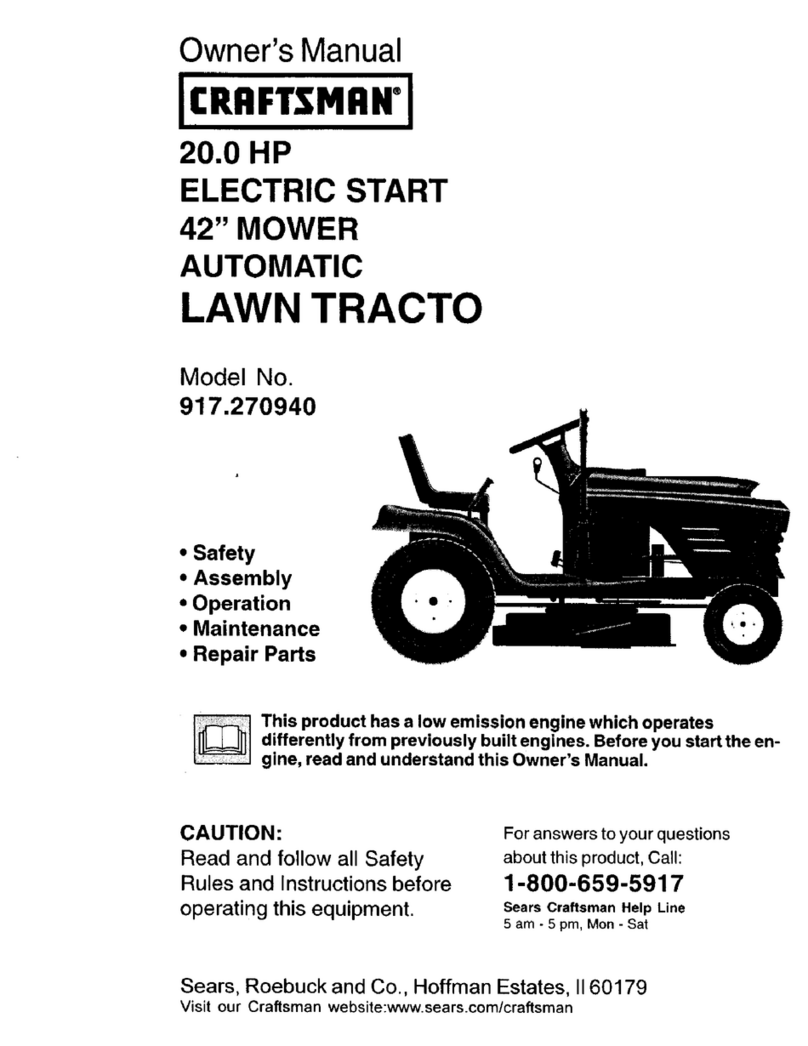
Crafstman
Crafstman 917.270940 User manual
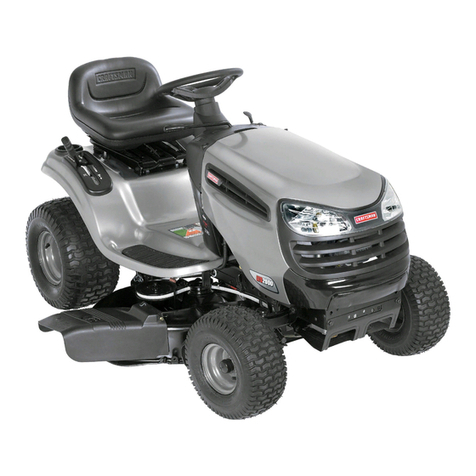
Crafstman
Crafstman 917.28910 User manual
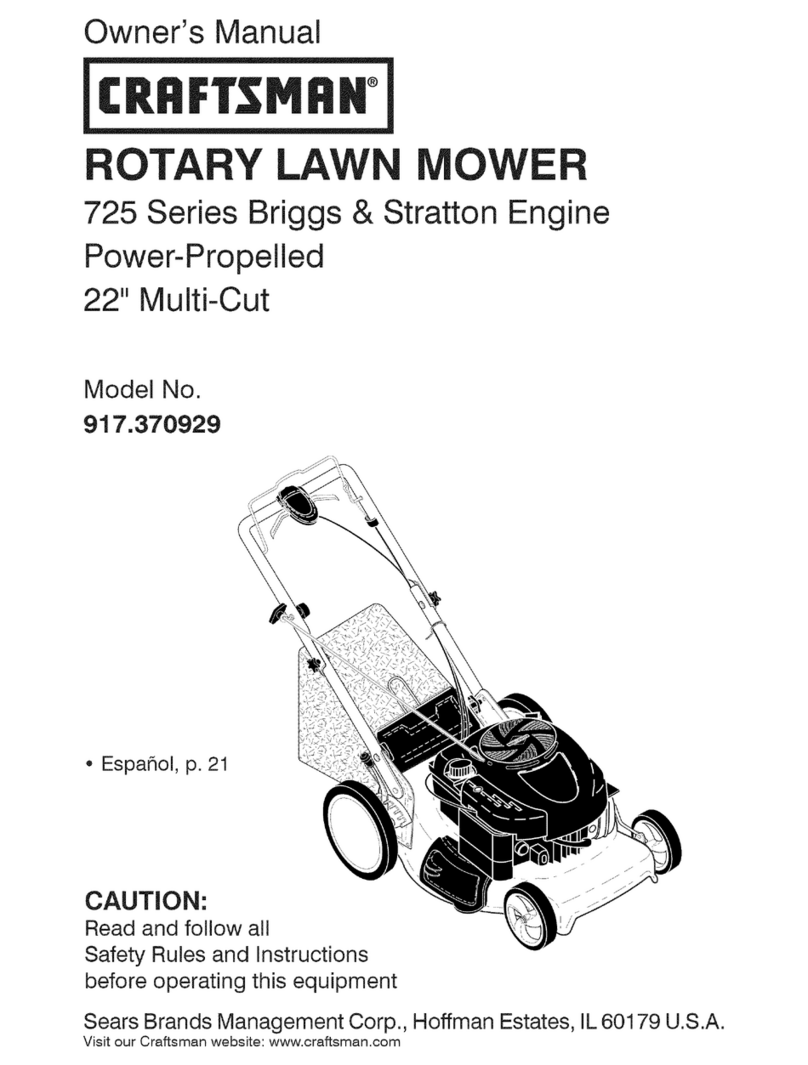
Crafstman
Crafstman 917.370929 User manual

Crafstman
Crafstman LT 2000 User manual
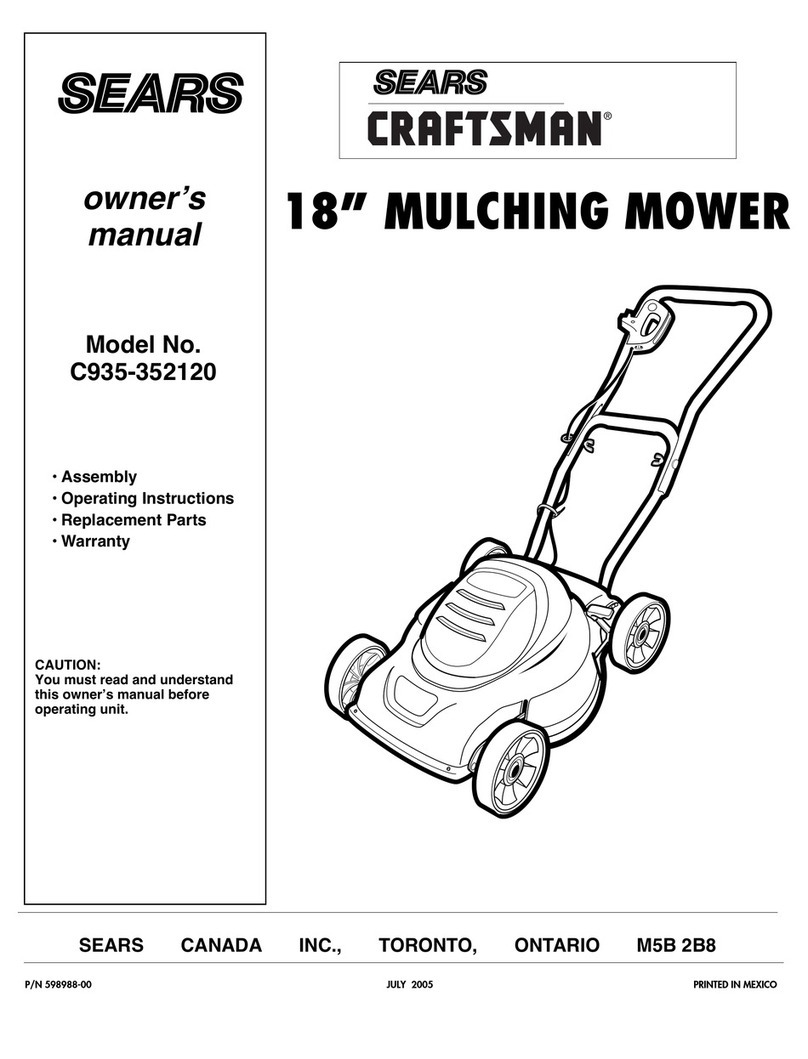
Crafstman
Crafstman C935-352120 User manual
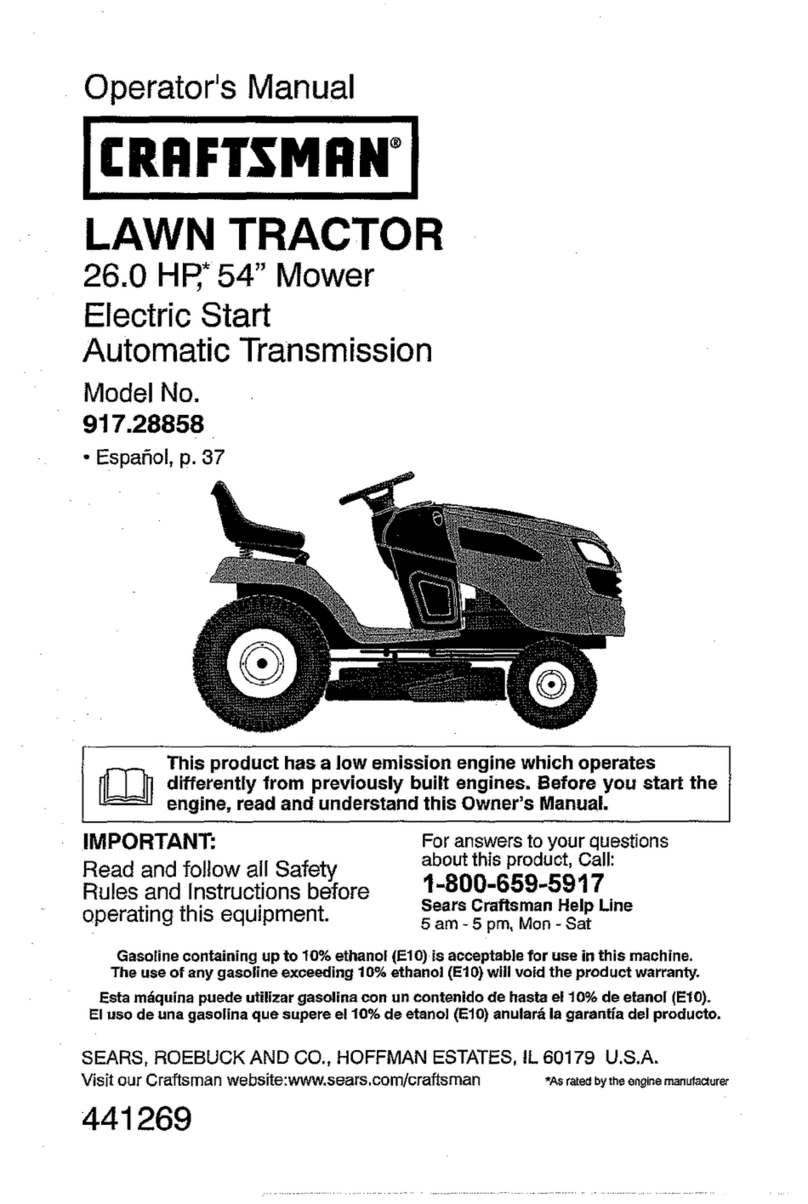
Crafstman
Crafstman 917.28858 User manual

Crafstman
Crafstman 10t802 User manual
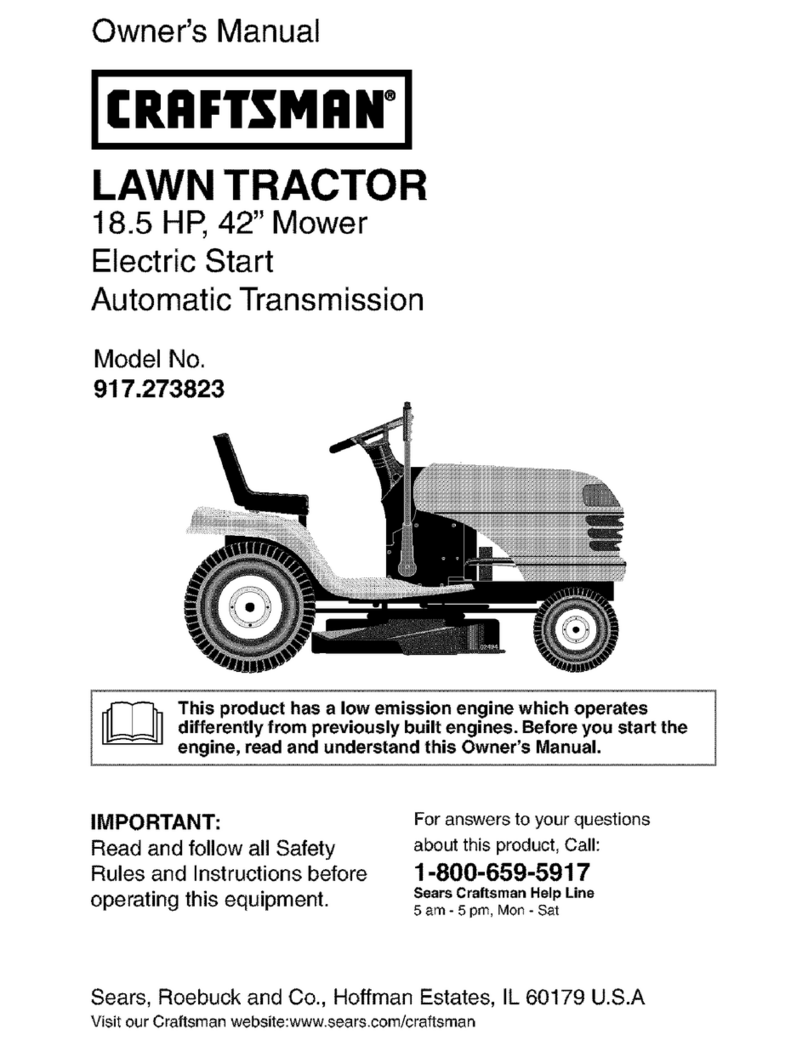
Crafstman
Crafstman 917.273823 18.5 HE User manual
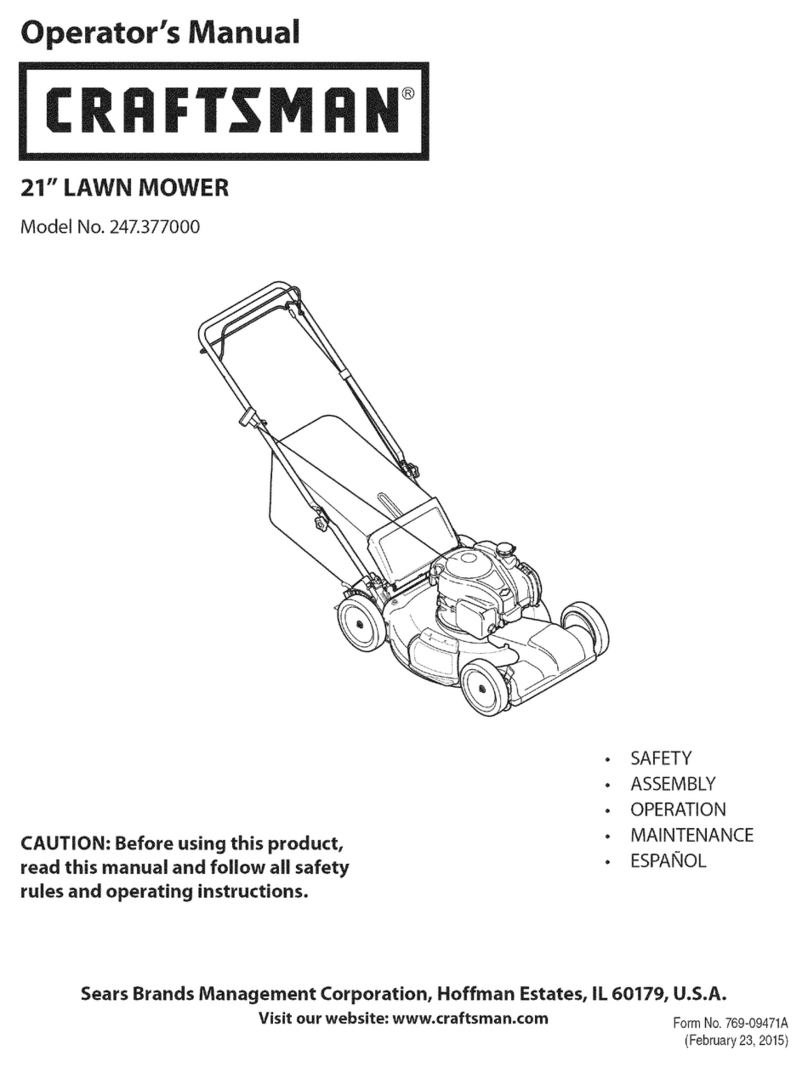
Crafstman
Crafstman 247.377000 User manual


